


Now is the time to reach new heights.
THE TRACCESS T135, T170, T200, T230 AND T270 WILL TAKE YOU AND YOUR BUSINESS HIGHER, SAFER, FOR LONGER.








THE TRACCESS T135, T170, T200, T230 AND T270 WILL TAKE YOU AND YOUR BUSINESS HIGHER, SAFER, FOR LONGER.




The Federal Government’s National Skills Commission lobbed a bulky report into the public arena in June 2021. As government timelines go, that makes it fairly current, and the topic of this no-doubt incredibly expensive missive is Skills Priority List
There’s a great deal of methodology and explanation to wade through before arriving at the gist of the whole exercise, but to put the 25 pages in a nutshell, there are a substantial number of occupations in Australia which are having trouble finding serious, properly trained practitioners. It won’t be news to anyone to read ANZSCO code 362212, Arborists, were rated as in seriously short supply (212412 Editors and 212413 Print Journalists appear toward the bottom of the ‘No shortage’ category, by the way, not far below 149111 Amusement Centre
Manager, but still a few steps up from 452211 Bungy Jump Master).
At first glance a serious shortage of qualified people is a pointer to a real problem, but it’s also a big opportunity, clearly recognised in the report which places arboriculture’s five-year growth outlook as ‘strong’, right across our treecovered nation.
Australia’s arbor associations have obviously recognised the problem and embraced the opportunity, offering exceptional training and qualification processes, ably supported, as always, by TAFE.
Still, offering good training doesn’t necessarily mean that training will be embraced, especially by school leavers and other younger generations who can assure the industry’s future. Engaging the interests of that vital demographic
probably needs the services of 225113 Advertising and Marketing Professionals – another group not in short supply according to the report – and that’s a big leap out of the arboriculture comfort zone.
But there it is. I certainly don’t have strategies guaranteed to ensure the future of Australian arboriculture, but let’s hope the people who have that vision can get together with people who have the expertise to illustrate the bright outlook to a large and receptive possible workforce. Australia’s rapidly accelerating development has an increasing need for people who understand the importance of arboriculture in an ecologically balanced and sustainable future. Otherwise we might all be looking for work as Bungy Jump Masters.
Manufactured for the Australian market, the Snorkel line of trailer-mounted boom lifts features a range of capacities and lifting heights along with an array of features to suit a variety of applications. Read more on pages 48 and 49.

The Australian Arbor Age is published bimonthly by Prime Creative Media Pty Ltd.

CEO
John Murphy
COO
Christine Clancy
Sales Director
Bradley Buchanan
National Advertising Manager
Sue Janjic suzana.janjic@primecreative.com.au Mob. 0419 531 401
Client Success Manager
Arianna Lucini arianna.lucini@primecreative.com.au
Editor
Tom Foster tom.foster@primecreative.com.au
Design
Tom Anderson
Subscriptions
P. +61 3 9690 8766 subscriptions@primecreative.com.au
Website www.arborage.com.au

Copyright
The Australian Arbor Age magazine is owned by Prime Creative Media and published by John Murphy. All material in The Australian Arbor Age magazine is copyright and no part may be reproduced or copied in any form or by any means (graphic, electronic or mechanical, including information and retrieval systems) without written permission of the publisher. The editor welcomes contributions but reserves the right to accept or reject any material. While every effort has been made to ensure the accuracy of information, Prime Creative Media will not accept responsibility for errors or omissions, or for any consequences arising from reliance on information published.
The opinions expressed in The Australian Arbor Age magazine are not necessarily the opinions of, or endorsed by, the publisher unless otherwise stated.
© Copyright Prime Creative Media, 2023
Articles
All articles submitted for publication become the property of the publisher. The editor reserves the right to adjust any article to conform with the magazine format.
Head Office
379 Docklands Dr, Docklands VIC 3008
P: +61 3 9690 8766
enquiries@primecreative.com.au www.primecreative.com.au
Sydney Office
Suite 3.06, 1-9 Chandos Street
Saint Leonards NSW 2065, Australia
P: +61 2 9439 7227
New state-ofthe-art facility for Monitor Lifts

Cassian Humphreys
Cassian is a Merrist -woodian graduate (NCH-arb- 1991) qualified to Diploma level in Australia (09), his career commenced in Horticulture (85) and transitioned into Arboriculture (89). An experienced tree climber, instructor, rboriculturist, consultant, educator and writer, he has 30 years of experience. He sees his work as making a contribution to the Australian arboricultural profession.

More awesome gear and a new catalogue from Husqvarna

06.
08. ON THE COVER Husqvarna’s X-PRECISION™ SP11G chainsaw chain cuts like a scalpel

10. TECHNICAL FEATURE
Tree care for the land custodian: part two By Cassian Humphreys
20. TECHNICAL FEATURE
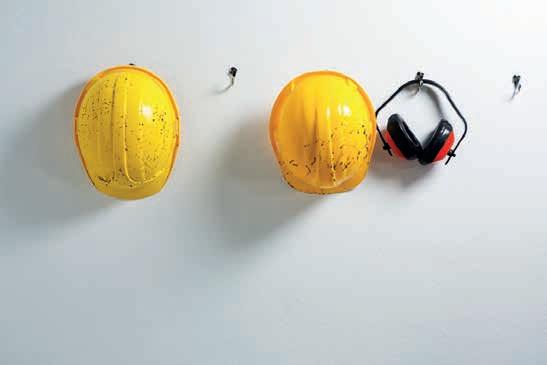
Tree roots: cut or break By Peter Gray
28. TECHNICAL FEATURE
Arboricultural tests By Jim McArdle
42. Australia to host international forestry forum

70. Arb can help
54. VEGETATION MANAGEMENT
55. Intermercato: New year, new grapple saw!
56. Morbark Next Gen 6400XT Wood Hog horizontal grinder
60. Gibson’s Stump Grinding: A Vermeer Australia success story


62. Why Urban Arb Solutions chooses Bandit
64. Först’s 8 Series wood chippers
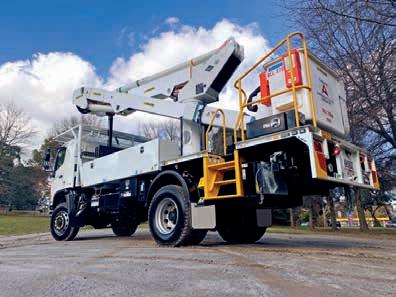
66. Forest Centre and Bluey’s Tree Removals
68. Addicted to Gardens: addicted to Hansa
The International Journal of Environmental Research and Public Health has reported a study in Japan had 585 young adults relate their moods after spending 15 minutes wandering around a forest and 15 minutes in an urban setting.
The forests and urban centres were in 52 different locations around the country, and up to a dozen participants walked in each area.
In all cases, the participants walking in a forest experienced less anxiety, hostility, fatigue, confusion, and depressive symptoms, and more vigour, compared to walking in an urban setting. The results were even stronger for walkers who’d been feeling a tad anxious before they started.
“The psychological benefits of walking through forests are very
significant, and forest environments are expected to have very important roles in promoting mental health in the future,” the authors concluded.

There are other studies which suggest the practice of shinrin-yoku —deliberately spending time among trees—can help deal with the stresses and strains of urban living.
It’s not news to us, but it’s nice to have it confirmed.
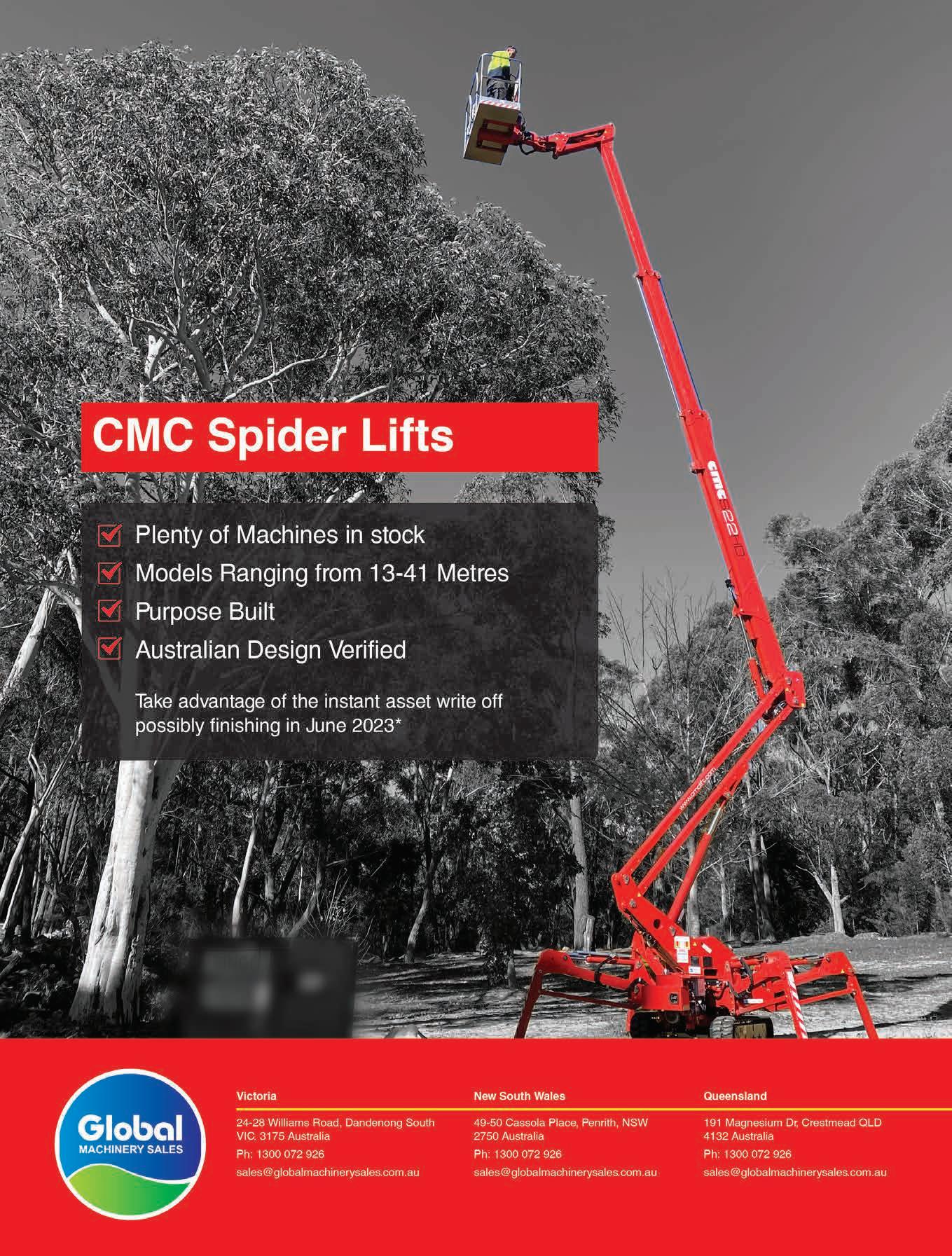



Developed for precise and gentle pruning of smaller or delicate branches.
H usqvarna’s X-PRECISION™ SP11G is a semi-chisel, ¼" mini, 1.1mm chainsaw chain developed for precise and gentle pruning of branches with diameters up to 15cm.
Clean cuts help the tree to heal well and look good afterwards, and the SP11G is a narrow, low-profile chain with
low weight and low noise that operates smoothly and efficiently with both battery and small-size petrol chainsaws – it’s perfect for the Husqvarna X-PRECISION™ ¼" mini guide bar.
The chain cuts like a scalpel and is excellent for urban tree-care professionals like Ryan Roberts of
Diligent Tree Care. Ryan’s been using Husqvarna’s new chain for a while, and he’s really excited about it.
Based on the NSW central coast, Diligent Tree Care has a work schedule most pro arborists would find familiar.
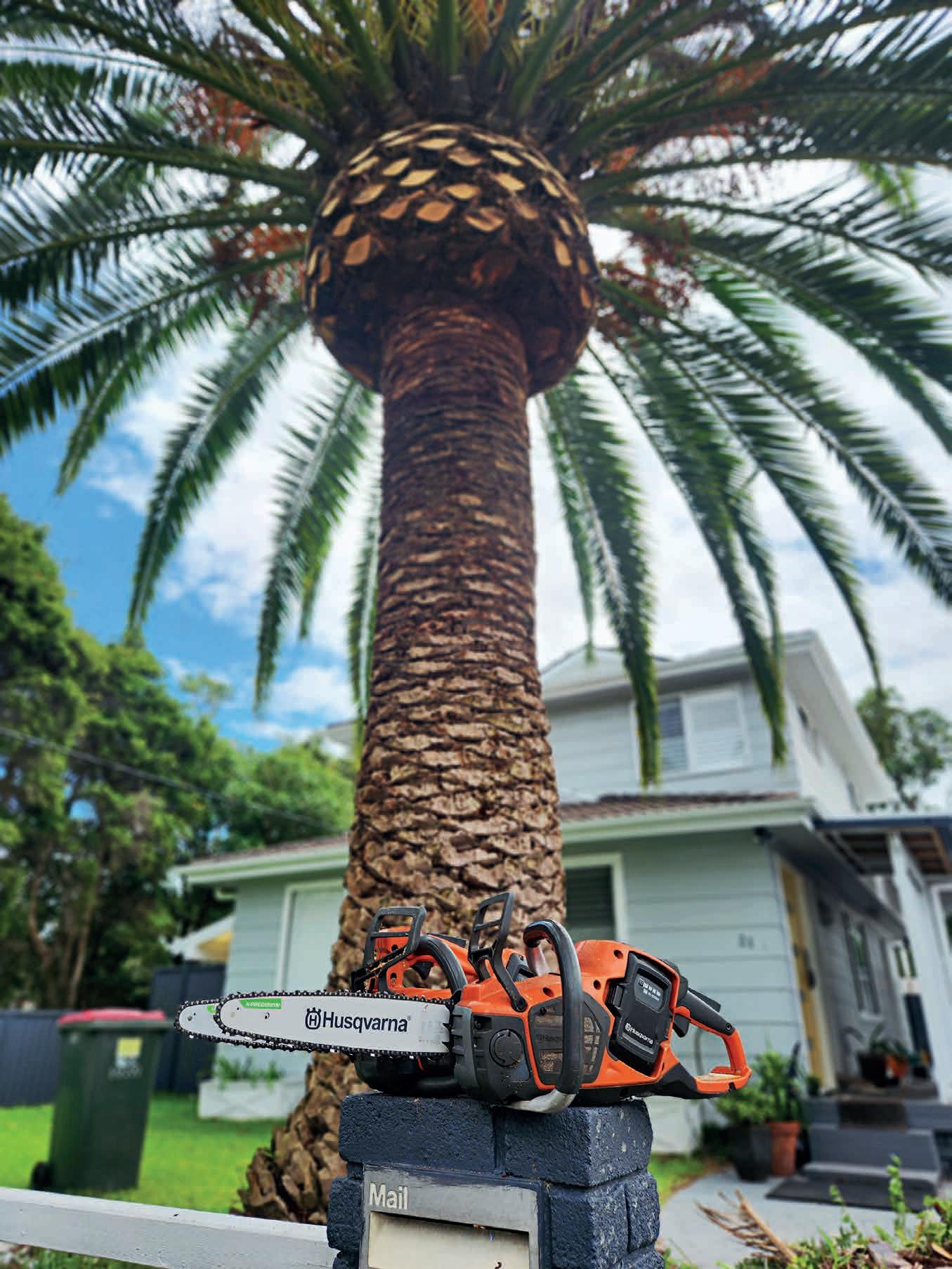
The SP11G is a narrow, low-profile chain with low weight and low noise that operates smoothly and efficiently with both battery and small-size petrol chainsaws.
Generally the work is mainly pruning, but emergency storm work and treeremoval jobs are common enough.
“The new Husqy chain is noticeably different to the chains I’ve been using regularly,” said Ryan. “It’s razor sharp, and it’s pretty much like using a hand saw. When you’re pruning it just glides through the collar cuts. It’s very precise, with no rips or tearing.
“With intricate work on smallerdiameter branches, it’s really neat.”
“Ryan’s experience is exactly what Husqvarna was trying to achieve when this chain was designed,” offered Jason Bezzina, Product Manager Husqvarna Australia. “Essential attributes of the SP11G include exceptional cutting performance, low vibration, and increased safety, control and manoeuvrability.”
“The SP11G chain’s manufactured to the highest standards and designed with an optimal cutter profile and technical innovation that provides stay-sharp durability and precision, cut after cut.”
Just quietly
Ryan’s been working with the 10-inch chain on his Husqvarna T540i XP® and the 12-inch on his Husqvarna 340i, and
he’s obviously very impressed.
“This chain definitely holds the sharpness,” he beamed.
“The chain is ideal for the intricate and small-to-medium pruning I do…limbs up to about 10 inches. If you’ve got a 12-inch bar on anyway, you wouldn’t cut any bigger than that.
“It’s definitely ahead of other chains I’ve been using. It’s fast-cutting, super neat, incredibly sharp, and it does stay sharper for longer.”
“I’ve also noticed it’s a lot quieter,” mused Ryan. “I don’t know if it’s got to do with the chain speed and it having more teeth, and maybe with the sprocket it uses, but it’s noticeably quieter than other chains I’ve tried.”
Jason enlarged on that impression: “The narrow, low-profile design provides outstanding cutting performance and quieter operation by reducing vibration and friction, assisted by optimal

lubrication, improved ergonomics and optimal cutter profile to maximise power and efficiency.”

Ryan’s matched the chain with Husqvarna’s X-PRECISION™ ¼" mini guide bar, and he energetically lit up as he told us about it.
“It’s amazing!” he insisted.
“Because of the narrow tip, if you’re doing a small tree, like an ornamental pear or something similar, you can get in without nicking other branches when you’re working in a tight area. That’s why it’s different from the other bars, and that’s why it’s special.”
“The smaller nose radius allows for ultra-precise cutting with increased manoeuvrability and accessibility in tight or awkward spaces,” added Jason. “It makes it ideal for specialist and intricate pruning.”
Find out more about Husqvarna’s SP11G at husqvarna.com.au.

WORDS AND IMAGES: CASSIAN HUMPHREYS

Plants are living pumps for the nutrient cycles on which all life is dependent. They harvest inorganic nutrients from the atmosphere and make them organic by embodying them. A large amount of the carbon they store is also shared in the form of carbohydrate – sugars – below ground. This is gifted in exchange for water and elements like phosphorous, nitrogen, potassium, magnesium, copper, sulphur, zinc, calcium, molybdenum, iron, chromium, cobalt, iodine and so forth. Science observes that mycorrhizae – classical Greek for ‘mushroom-root’: part plant/part fungi – enable up to 10 times the nutrient assimilation compared to a tree’s root hair operating alone.
One thing is very clear with the science on the soil-food-web (often called the wood-wide-web): woody-plants in nature cannot succeed without association. We negate the natural plant/micro-biome by biologically desertifying soils, with the end result being stress, sickness, pests, disease, and short lifespans.
Though we can get away with short-lived plants in a nutrient-deficient cropping-cycle reflective of agriculture,
A veteranised ancient Marri-gum – Corymbia calophylla –which also featured in part one. It’s a significant habitat tree with an active hollows and natural crown suppression. Study of its growing environment yields much in the benefits below ground, benefits that are best expanded on, and offered up to other ancient and veteran trees in similar locations. This tree is a very interesting study. Although it would certainly have been challenged by roadside construction – evidence of a history of Marri Canker is a sure sign of past stress – two-thirds of its rootzone is plugged in to the kind of species diversity the tree evolved with. Species-diverse ecosystems Downunder are reflective of poor soils and nature’s tendency to grow species-rich ecosystems to assist with nutrient sharing and nutrient assimilation.


The Snorkel MHP15HD heavy-duty trailer-mounted boom lift is the portable solution to effortless mobility when at multiple jobsites. Towable by SUV or utility, this rugged reliable boom lift features a superb working envelope for up and over access to awkward areas and outriggers provide maximum stability for work as height.

14.8m Working Height I 200kg Platform Capacity I 540˚ Turntable Rotation
For more information on the SNORKEL MHP15HD, please call 1300 900 700 or visit ahernaustralia.com.au.
 SNORKEL MHP15HD ENGINEERED FOR SAFETY | PROPORTIONAL SPEED CONTROLS | HEAVY DUTY DESIGN
SNORKEL MHP15HD ENGINEERED FOR SAFETY | PROPORTIONAL SPEED CONTROLS | HEAVY DUTY DESIGN
One of the current fringe landcare movements involving plant diversity is Syntropic farming, which involves the growing of five different genera of associate plants in a crop environment.

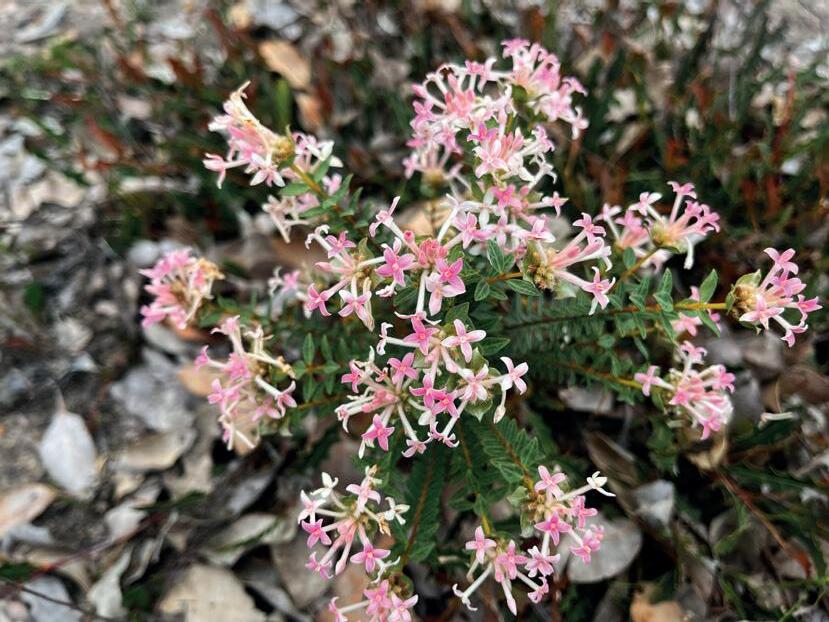
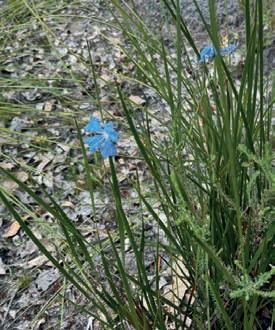


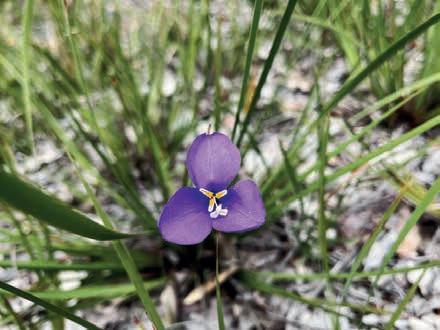
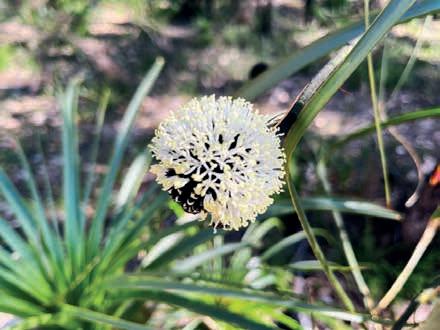
Syntropic Farming recognises the soilfood-web science, now shining a light on plant associations, is demonstrating the shared resources helping build resilience are more than just nutrients. Plant associates literally program each other to succeed with acquired experience and information via the micro-biome. This will sound far fetched to those who lack natural intelligence (NI), yet to the ‘street-smart’ it’s obvious. It’s true to refer to an intact ecosystem as a literal biological computer program, and in southwest WA there are still some pristine ecosystems.
There to see
In nature, natural intelligence unites all. Recognising the natural biological exchange between plants and their living associates, where via the

To demonstrate my research I’ve provided a record of all the native understorey plants I found growing in association with Marri-gums within a two-month flowering time. All were photographed under the Brockman Highway ancient Marri-gum shown at the start of this article, and Maslin Reserve, Bridgetown, WA, a local Marri and Jarrah Gum woodland. There are up to 13 different associate genera in this record, with 30 different species.
rhizosphere trees bargain for minerals in exchange for sugars, is key. When we compare this to stripping soil life via mechanisation, fertilisation, pest and disease control, or biological desertification, it’s an illustration of artificial intelligence (AI) versus NI. We can call this humanity’s ego versus creation.
Regardless of what we believe, nature
is a masterfully fine orchestration, and the other a drug-induced 80’s rendition by comparison – Mozart V Culture Club, perhaps?
Experience of the oasification of southwest WA, famed for being one of the most biologically diverse regions on Earth, yet on the poorest of soils, is a huge awakener (there are parallels to the east-coast rainforests).
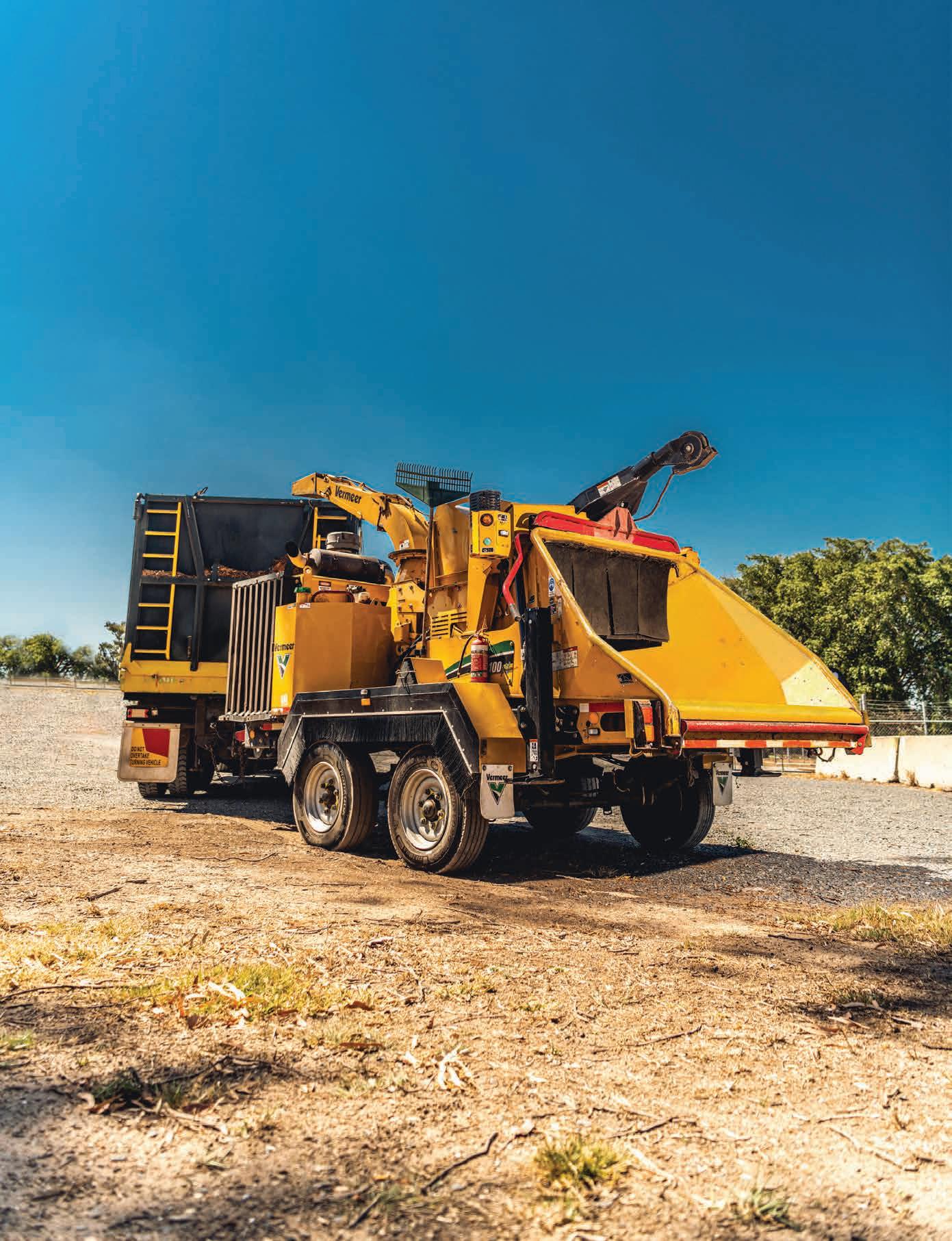
The nutrient cycle: Plants as pumps for the nutrient-cycle (the primary producers) harvest their own energy from sunlight. They harvest elements and water from both the soil and atmosphere (in association with the microbiome). They synthesise the sun’s energy with inorganic atmospheric elements, embody them and then make them available (in organic form) to all life. With animals and humans (secondary producers) that eat plants, or eat other animals that ate plants, so the cycle shifts from the Atmosphere to the Earth via the plant bodies, followed by the creatures. So it is true to say that functioning as living pumps and in being pumps for the nutrient-cycle plants unite our atmosphere and earth.



VERMEER AUSTRALIA HAS BEEN AT THE FOREFRONT OF INNOVATIVE SAFETY AND PERFORMANCE FEATURES IN OUR TREE CARE RANGE FOR MORE THAN 60 YEARS.
The BC2100XL is a standout in our wood chipper range. With a full function remote control, and offset horizontal feed roller, disposing of tree materials has never been safer. Plus, you’ll be backed by the service and support of Australia’s largest tree care equipment dealer network. Contact your local Vermeer Australia team to try it for yourself.

We have known of these associations in arboriculture for decades, yet it’s only now treating soils is starting to become mainstream practise, known as Plant Health Care. Tree Health Care is well established as a service in the US, although now, with the climate-change initiative, Australian arboriculture is starting to get serious as we unite cultural practises that attend both ends of the pump.
As a pioneer in the Australian Conservation Arboriculture movement, I am very excited to see trees, the living backbone of land-based ecosystems, are starting to get the attention they deserve. As part of my personal initiative to be integrated as a landcarer, I have shifted my focus from arboriculture into naturaculture. Under this banner, through education, I aim to make conservation arboriculture available to all who make up landcare, from professional vegetation-managers to land custodians.

What is it the land-custodian needs to know to be a landcarer?





It’s not enough to care for Earth in concept, statement or politically. This has to be as a field-cultural practice, otherwise there is no benefit to Earth. This is about managing, conserving, utilising, and co-creating resources in concord with Earth’s biology.
Unless programmed by NI, AI is of little use here.
Let’s make it simple – a challenge when we see how complex academic science makes natural science. To get sustainability, to literally rewild Earth, we need to understand the nutrient cycle. Misunderstanding this is a major roadblock that keeps land managers stuck in the loop of futile controls that yield a multitude of side effects which cost way more than they benefit.
In support of this series narrative, following are some naturacultural terms and practises, with explanations, I created:
• Naturaculture – Latin for the culture of nature
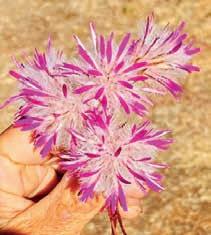
• Nutrient bed – the carbon component of an ecosystem

• Plant system – the plant component of an ecosystem
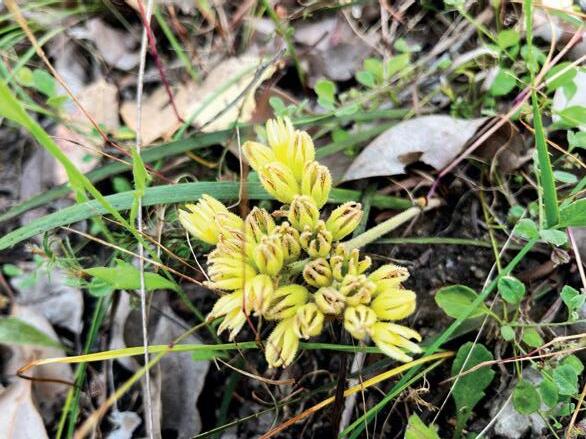

• Oasification – based on an oasis, the opposite to desertification
In the mix of local understorey plant associates, we have the Australian Bluebell, Clematis, three species of Rice flower, a Grass tree, Pultenaea, Patersonia, Fringe Lily, Lomandra, Ptilotus, Kangaroo paw and the Southern cross (half the species have yet to be IDed). Not photographed, but seen on site, were species of Native Wisteria, Coral Vine, Tassel Flower, Cycad, Leucopogon, Nuytsia and Acacia – 30 species of tree-andplant associate. This list does not include those plants not in flower.
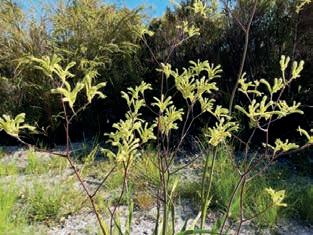


• Aeration – soil oxygenation, an essential strategy in the naturacultural toolkit
• Tree Health Care – tree health is insurance against tree failure, biologically and biomechanically. Like healthy humans, healthy trees are naturally resilient to disease and breakage. Tree diseases like Phytophthora, Phellinus, Chrysoporthe, Marri-Canker, CankerSyndrome, and Polyphagous-Shothole Borer are common signs of desertification. Healthy trees are resilient. Stressed or ‘sick’ trees are not. Ensuring tree health is all about sustaining healthy, biologically diverse soils, supported by air, water, carbon, minerals, and the microbiome.
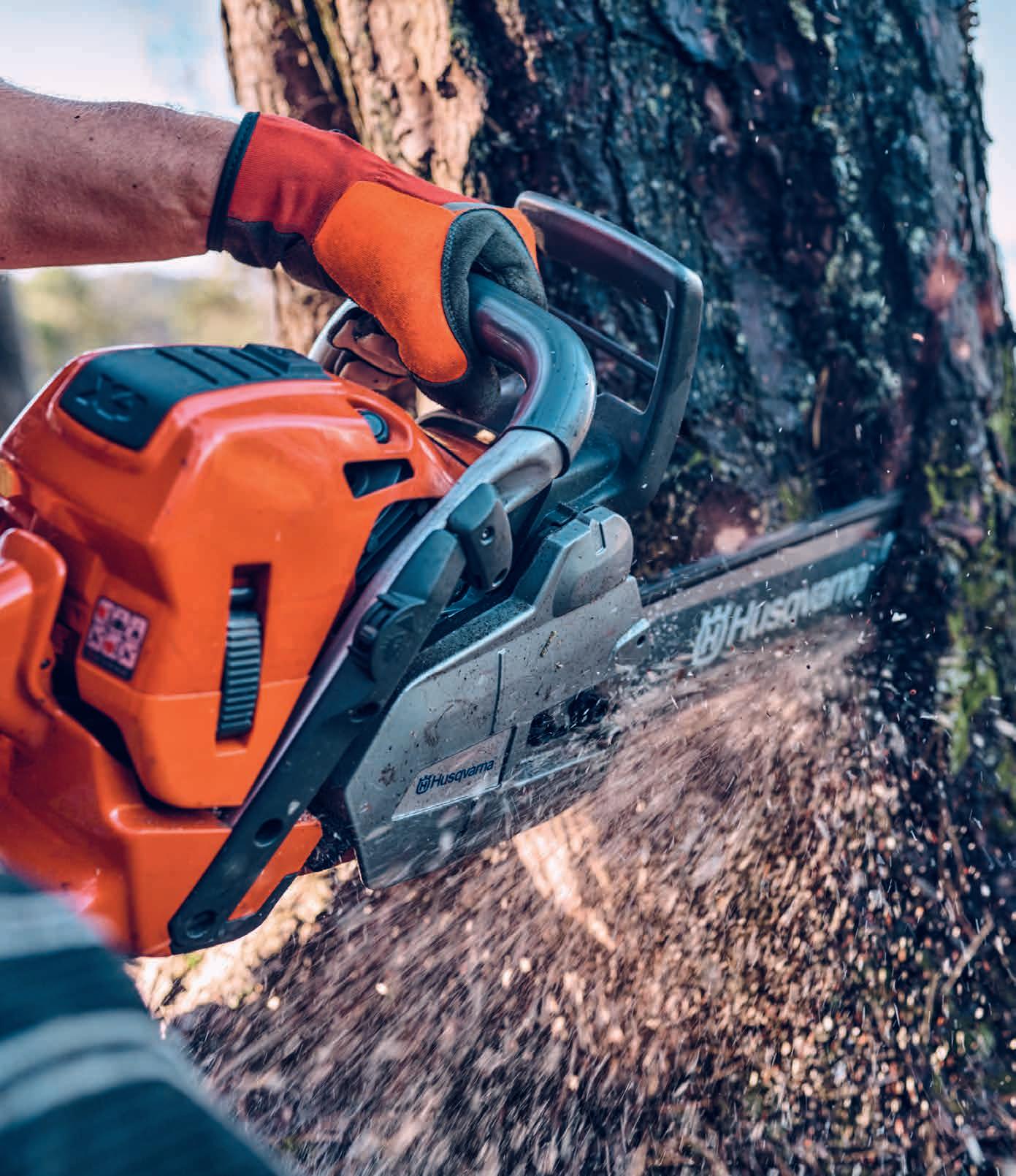
I have witnessed natural rewilding of roadside verges adjacent to State Forest and National Parks in southern SA and southwest WA. As a result of decades of people pressure and herbicide application adjacent to urban and rural land, weeds are generally better supported than native-plant regeneration. This is also true of many failed revegetation projects when the below-ground microbiology is missing. In such growing conditions there is no reason to add biology. For the sake of the Ancient Marri-gum shown on these pages, all I would add is air via verticalfissure work. With historical roadsidegrading, it is likely compacted soil will still exist, and with natural microbial propagation in the face of re-opening the soil, and rewilding with understorey plant proliferation, nature will look after the rest.


However when it comes to treating this McLarty Street Bridgetown Marrigum shown in Figs 4-5, based on its turfbased growing environment, I would gift this forest legend the whole bottom-end package.
As discussed in my podcast and in Part 1 of Tree-Care for the Land Custodian, Marri-gum is one of the best examples of a phoenix tree I have seen in WA, a specialist at transitioning from a forest tree into field-pasture tree. In Fig 6 we can see the original upper crown, formed when this tree stood in a high forest, in Fig 7 (delineated by a dotted line) we can see the lower crown forming since forest clearing. What
science of
I’ve witnessed of this legend genus to date is that with sufficient vitality, old-forest trees will generate canopies to the ground, optimising the full biomechanical benefits of being fieldpasture trees.
It’s the Alpha-trees that are adept at such transition.
With homage to such tenacity I would gift this tree a 25m by 25m treatment area, largely outlined by the tree’s dripline, excluding the Structural Root Zone, with three vertical fissures every square metre, and another three smaller fissures for tube-stock understorey


plants (the species listed above), and hand forking the soil surface with mulching, framing the outer area and capping with logs to help mitigate future people pressure and soil compaction. This involves the establishment of a nutrient bed and plant system.




Based on study of Maslin reserve, I would include nature’s biochar in the mix. This cultural/contractual process is covered in my AA article The Heart of Arboriculture in the Oct/Nov 2021issue. With my new website and educational workshop series, this process is to be offered up to the landcare professions via a workshop Australia-wide, starting with Canberra.

Another important transformational feature learned from Marri-gums is the





capacity for this species to recover from major crown failure – to generate a new crown even from fractured snags.


The Marri-gum’s generation of buds, leaders and limbs from delaminated, fractured and decayed snags is second to none. Study of Maslin Reserve for some weeks, and a brown-rot decay fungi common to the forest and throughout southwest WA, has shown me this is a fungi that has co-evolved with the local gums. It assists the process of decaying internal ballast via processing the heartwood into compost.
An essential forest fungal organism – the many downed composting logs in the reserve are testament to this – this fungi is an important means to help rebirth new trees out of the old

snags. The decayed heartwood itself is a significant resource, with the cellulose degraded by the fungi and lignified tissue retained, literally nature’s biochar. Manmade biochar has the cellulose burned from it, and as a porous, ligninrich resource, it is excellent at housing microbiology. Biochar commonly infused with compost tea is proving to be a popular resource throughout landcare. Examples of the limits of hot burns (overcooking) verses cold burns are across the board in nature (this relates to managing forest fuel load, as well as creating compost), therefore I aim to initiate a microbiologist’s analysis of man-made biochar verses aged brownrot. Knowing nature I suspect the wildbiochar is infinitely more superior. Long live the tree, and long live conservation arboriculture.



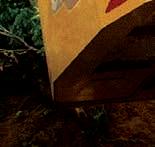

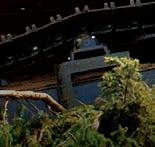
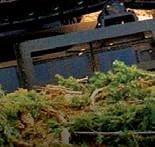
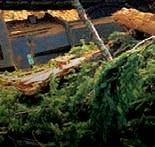

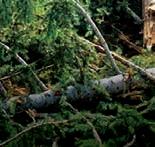
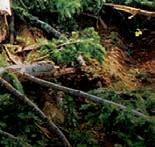




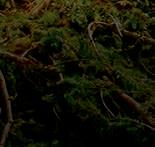



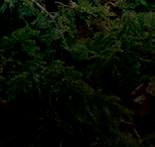



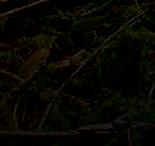


























































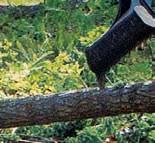
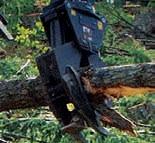


















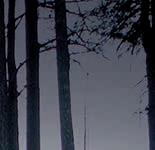



WORDS AND IMAGES: PETER GRAY



Successful retention of trees in development sites is important if the tree cover in the urban environment is to be increased. If cutting tree roots cleanly can be shown to increase the new growth of tree roots and prevent the spread of decay up the roots, then this practice should continue to be encouraged. A study was planned and carried out to determine whether that is the case.

The Australian Standard AS 4970-2009 Protection of trees on development sites gives guidance on how best to manage development that affects trees. This includes dealing with tree roots and excavation around trees. Section 4.5.4 of the Standard advises tree roots should be cut cleanly and that ‘pruning’ roots with an excavator is not acceptable. There appears to be little research to support that contention.
In October 2019 the first of two studies was conducted on the NSW north coast in an area with an average annual rainfall of 1200 mm. The soil type was red-clay loam.
The soil was dug out with an excavator to half a metre in depth. Most of the roots were encountered in a zone 150mm wide approximately 300mm below the surface of the soil. There were three sites, each with a different species of tree.
The three different species chosen were:
• Flooded Gum (Eucalyptus grandis)
• Moreton Bay Fig (Ficus macrophylla)
• Camphor Laurel (Cinnamomum camphora).
These particular species were chosen because they’re relatively common and were growing on the available sites.
Three different methods were used to sever the roots of the trees. Some were broken off with an excavator, and some were cut cleanly with a concrete cut-off saw, and some were cut using a stump grinder.

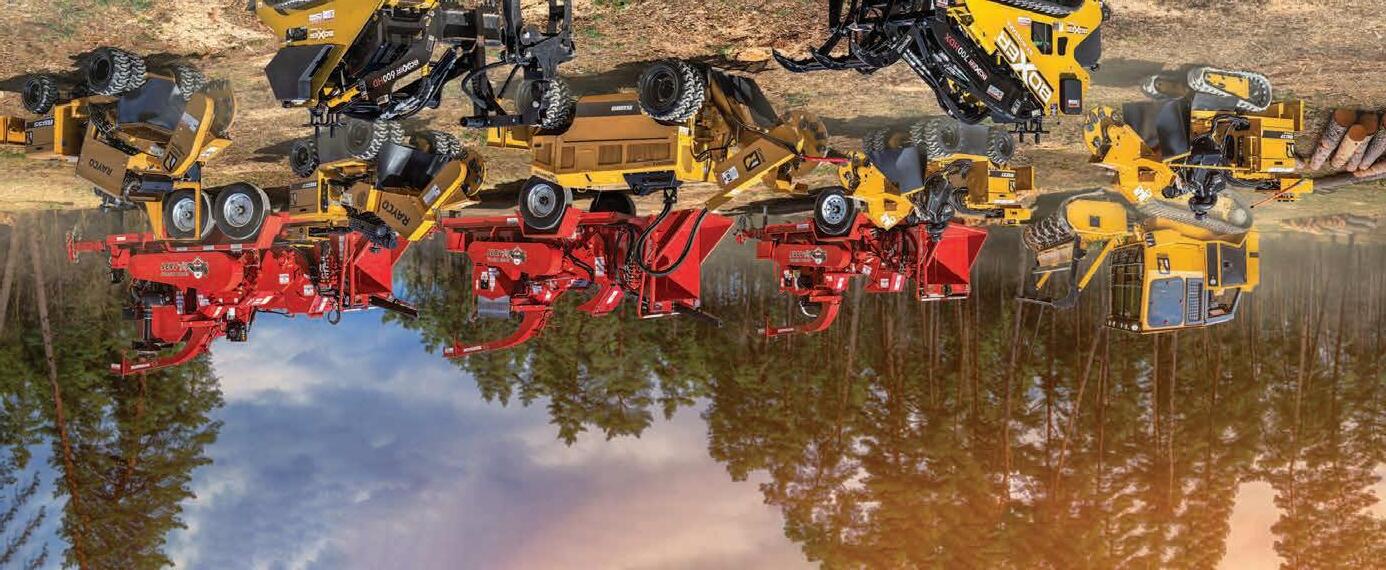
The Flooded Gums were a row of mature trees that had been planted and were approximately 30-50 years old. The excavation was done approximately three metres from the base of the trees.
The Fig tree was a single tree growing in a paddock previously used for grazing and was around 50 years old. The tree was likely to be naturally occurring, and the excavation was carried out approximately five metres from the base of the tree.
The Camphor Laurels were in a stand of naturally occurring trees approximately 20-30 years
You begin each day before dawn with a drive and determination to do more than the day before. When you move at this pace, you know to do more you need equipment that is made for more. That’s why our equipment is built from the ground up to meet your needs, delivering:
More Power and Production
Lower Operating Costs
Ease of Maintenance
Greater Longevity and Resale Value
If you’re ready to operate equipment that’s made to keep pace with you, then we invite you to contact the authorized dealer in your area of the world. To learn more about our equipment go to www.morbark.com.

Global Machinery Sales - VIC/NSW/QLD
Ph: +61 1300 072 926
www.globalmachinerysales.com.au

24-28 Williams Road, Dandenong South, VIC 3175
49-50 Cassola Place, Penrith, NSW 2750
191 Magnesium Dr, Crestmead, QLD 4132
Greenstar Equipment - QLD (Boxer Only)
+61 1300 767 589
greenstarequip.com.au

1 Chetwynd St Loganholme, QLD 4129
SA Tractors -SA (Boxer Only)
+61 8 8349 7500
satractors.com.au
Unit 12, 160 Churchill Road North, Cavan, South Australia 5094
Stevens Products
+64 9 275 0443
stevensgroup.co.nz


293 Landing Drive, Mangere, Auckland, New Zealand
Westco Equipment - WA
+61 (8) 9258 9333

westcoequipment.com.au
14 Clapham St, Beckenham WA 6107
old. The excavation was carried out approximately three metres from the base of the trees.
The trench was backfilled and left for one year. In September 2020 the roots were uncovered using an airspade and examined.
The roots broken with the excavator had responded much better than the cleanly cut roots in terms of the number and size of new roots produced. These results were unexpected, but the number of replicates was small, and this suggested further sampling was required.


The next study used two species of tree and two methods of severing the roots. A row of planted Tallowwood (Eucalyptus microcorys) and a row of naturally occurring Camphor Laurels (Cinnamomum camphora) were selected for the study at a site similar to the one used in the first study. The trees were mature aged, approximately 25-30 years old, and all were in good condition.
In October 2020 a trench was dug with an excavator in the same way as the first study, approximately three metres from the base of the trees. Roots of different
sizes were left broken off by the excavator or cut cleanly using a reciprocating saw. The trench was backfilled with the soil that was excavated and left for one growing season.

In May 2021 the roots were uncovered using an airspade and examined for root-growth response. The diameter of the original roots was measured using a vernier calliper and the new roots that had grown near the severed end of the root were counted.
The ends of the roots were cut axially and were visually examined to determine the extent of decay.



 Second Study. Camphor Laurel root cut cleanly.
Second Study. Camphor Laurel root broken.
Second Study. Camphor Laurel root cut cleanly.
Second Study. Camphor Laurel root broken.


The findings are shown in Table 1. Camphor Roots and Table 2. Tallowwood Roots. A graph of the findings with one axis the size of the roots and the other axis the number of new roots is shown in Graph 1 Camphor Laurel and Graph 2 Tallowwood.
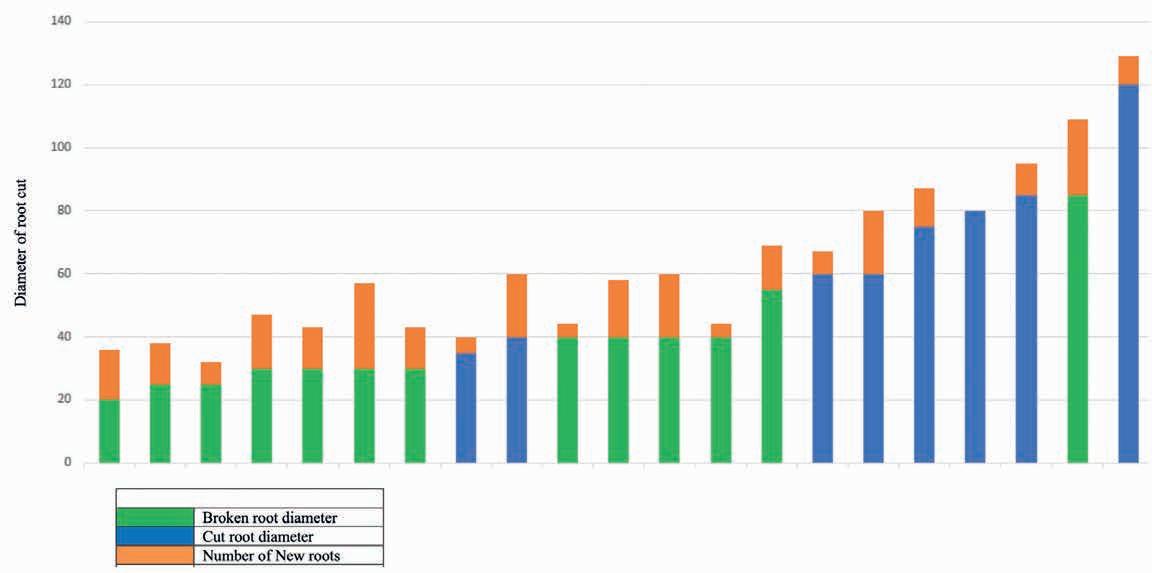
The findings of the 2021 research clearly show a correlation between breaking the roots and new root development. Roots that were broken consistently produced an increased number of new roots compared to roots that were cleanly cut. In all cases, the decay appeared to be well compartmentalised.
The study showed that regardless of the method used to sever the root. The extent of decay appeared to be more related to the area of the xylem exposed in the severing activity and not to the method of severance. It is surmised the presence of large amounts of parenchyma cells in the roots enabled the tree to inhibit the progression of decay and fungal attack. This was a consistent observation.
Camphor Laurel and Graph 2 Tallowwood show there is generally a greater number of new roots in the broken roots compared to the cleanly cut roots. The study shows breaking the roots off with an earthmoving machine does
not produce a worse result than cutting them cleanly. Additional information is shown in presentations Graph 1 and Graph 2. The photographs show new root growth occurred mostly along the margins of the wound.
While broken roots did have a larger wound margin (for equal diameter roots) they also had increased newroot formation.
Not surprisingly, new root initiation occurs from callus produced by the exposed cambium and adjacent parenchyma. If the root is cut cleanly the area of callus is reduced, limiting the ability of the severed root to initiate new root growth. If the root is broken off, a larger area of callus can develop.
Roots are not all the same. The type and distribution of tree roots varies widely with the species and soil conditions; however, tree roots are usually described as structural roots with rapid taper, sinker or striker roots, transport and storage roots – which are all woody roots – and absorbing roots (Eschel and Beekham 2013).
Woody roots form most of a tree’s root system. They include structural roots, a critical but small portion of the root system. The growing tip
and absorbing roots are small and ephemeral. The discussion of root pruning in the Standard is silent on which types of roots are being pruned.
In his work, Hamilton notes there is a high proportion of parenchyma cells in woody roots, and that no doubt influences the ability of roots to resist decay. He also notes that the removal of large lateral roots and the associated removal of large amounts of starch puts the tree under stress which can result in the decline or even death of the tree.
The canopy is needed to produce new carbohydrates which can then become starch that allows for the formation of new-root development. Therefore, it is important to limit the pruning of the tree’s canopy for a period before or after root pruning is done.
There have been studies that investigate the effect roots have on buildings (Biddle 1979;
McLeod and Cram 1996). Studies have shown the effectiveness of root -barrier systems (Morgenroth 2008; Smiley et al. 2009) and the effect of root pruning on the failure rate of trees (Hamilton 1989). There appears to be no work done that looks at the effects of cleanly cutting or breaking roots on decay and new-root generation.
The transport and storage roots
that comprise most of a tree’s woody roots vary from less than a millimetre in diameter to many centimetres in diameter, but are not in the zone of rapid taper.
The Standard does differentiate between cutting roots at the Tree Protection Zone (the TPZ) line or within the TPZ. It’s likely the roots referred to in the Standard are nearly all transport roots as the absorbing roots are very small, and there would be little difference between cutting and breaking absorbing roots. Root severance most commonly occurs outside the Structural Root Zone as defined by the Standard, or even as defined using the Zone of Rapid Taper.
There are practical difficulties with cutting roots cleanly.
First, they must be located, usually involving excavation that will damage smaller woody roots.
Often roots are ‘pruned’ with an earthmoving machine such as an excavator on development sites in spite or, or contrary to, any consent condition. Even once exposed and cleaned, cutting roots with hand tools can result in the tools being dulled and damaged.
Trees sometimes decline and die
after root pruning on development sites occurs. It may not always be root damage that causes or significantly contributes to their decline or death. There are other factors, such as changes to soil grade and pH, or changes to the water available can also affect tree health.
Many councils require roots to be cut cleanly. Often the rationale is failure to do this will cause the decline and death of the trees. The likelihood of roots decaying and causing disease in the tree is often cited. Hamilton has shown that the decline and death of trees after root pruning is more closely related to the amount of starch reserves lost in the process. The progression of decay in roots is inhibited by the high proportion of parenchyma in the transport roots, so, as the study shows, there is little difference in the spread of decay between roots broken or cut cleanly.
Breaking roots off does not result in more decay forming in the roots or less new root development than cutting the roots cleanly. The studies undertaken here showed that there was no difference in the decay based on the size of the wound, but did find an increase in the volume of new roots produced by breaking the roots rather than cleanly
cutting the roots. These results were limited to roots with diameters of less than 12cm and may not be applicable to larger-diameter roots. It is suggested that in the absence of supporting research that roots greater than 10cm in diameter continue to be cut cleanly, but that roots of 10 cm in diameter or less can be broken without adverse effect and with potential positive effects.
There is no reason for requiring roots less than 10 cm in diameter to be cut cleanly as outlined in the Standard. At best there is no benefit from cleanly cutting roots that need to be severed, and at worst, new-root production is being reduced.
BIBLIOGRAPHY
– Biddle P. 1979. Tree Root Damage to Buildings-An Arboriculturalists Experience. Arboricultural Journal 3:6 pp 397-412.
– Eschel A, Beekham T. 2013. Plant Roots the Hidden Half Fourth Edition. CRC Press. BocaRaton.
– Hamilton D. 1989. Significance of Root Severance on Performance of Established Trees. Arboricultural Journal Vol 13 pp 249-257. Academic Publishers. Great Britain
– MacLeod R. Cram W. 1996. Forces Exerted by Tree Roots. Arboricultural Advisory & Information Service. Surrey.
Morgenroth J. 2008. A Review of Root Barrier Research. Arboriculture and Urban Forestry 24(2) pp 84-88. SA.
– Smiley T, Wilkinson, Fraedrich B. 2009. Root Growth Near Vertical Root Barriers After Seven Years. Arboriculture and Urban Forestry. ISA.
Standards Australia. 2009. AS 4970 Protection of Trees on Development Sites. AustralianStandards. Sydney.

Keeping in mind a tree’s suitability for testing – whether for remnant status, security, tree health risk, contamination or other issues – there are myriad tests from the consultant’s toolbox which can give a broader view of a tree’s current status from above below ground or from due diligence.
1. Aerial Inspections can note species data associated with VTA and typical characteristics prior to a pre-climb.
• At the site of the anomaly/defect/ disease, the colouration of leaves, bark and any localised swelling of branches and/or stems, or changes to these, including cambium, are noted.
• View changing bark and note response wood.
• Mallet-testing surfaces around unions and changing surfaces. Gently stressing the branch to determine positive or negative holding wood.
• Photograph obvious defects and list height and direction.
Note the canopy along these defected areas and present a statement on the diameter of timber, holding-wood percentage (which may include decay measurements) and, where practical, measure these.
2. Canopy cover
• Look at Map canopy or OCCID patterns to determine percentage of canopy cover and photograph the canopy for record.
Note parasitic hosts, epiphytes and other vegetative organisms growing on the tree which are not part of the original tree’s structure: Strangler figs, Mistletoe, Old Man’s Beard, algae and fungal growths. Further lab testing will give more accurate observations.
3. A glucose and starch test can be used to determine the health of a canopy. New biosensors can monitor and measure glucose levels in real time, and this may be useful when determining cropping yields for food supplies. “The sensors now are used for basic plant-science research, but in the future, they can be used in
agriculture to optimise the conditions for growth, or to monitor the quality of the product, for example,” said Dr Eleni Stavrinidou of the Laboratory of Organic Electronics at Sweden’s Linköping University.
4. A browsing test involves viewing the leaf and stems to approximate the percentage of browsing insects or leaf damage. Discuss how this may impact glucose levels.
5. Phenology seeding of floral seasonal variants requires adding a sheet under a canopy and gently shaking the branch to vibrate or loosen seeds. The number can be counted as per population.
6. A branch-pull test opens discussion on the types of branch union and weighted estimations:
• State primary, secondary, tertiary branches and direction of exposure. May require an exit strategy and assurance that a target is removed or roped (secured) off the branch prior to testing.
• Throw a throwball and line up a tree on the designated structure and aim to use force, from gentle to whatever is desired. This process may include mechanical pullers at measured force.
• Watch the area of any likely fail and ensure it’s not occupied.
After ensuring that if the tree is likely to fail the arborist has taken precaution to tieback or stay the tree appropriately, check for anchorage, place two hands at a height of 1.5m and push, varying force from gentle to strong for small to medium sized trees or lever with larger trees.

Use a datalogger to measure stem movement over time. Long-exposure photography and video will allow for determining movement and variations outside a normal movement behaviour, and site cameras may reveal tree issues and can be noted at specific times and dates (especially for non-compliance).
Jim McArdle considers various tree-assessment procedures for the consulting arborist.Transplanting a palm (Mcardle 2020). Testing to determine best results for the site included site assessment, monitoring the moisture levels and roots 3v: volume vibrancy and vigour.
These tests will determine thresholds, fractures and densities of heartwood, allowing management or further monitoring and testing. The costs of these tests is usually prohibitive for the typical resident and are mostly done at council recommendation.
Note the Acacia or leguminous plants present and the introduction of small fauna that preserve the tree against pests. The issues of clearing this vegetation are stated in Ecoarborist issue 2023 Jan-Feb.
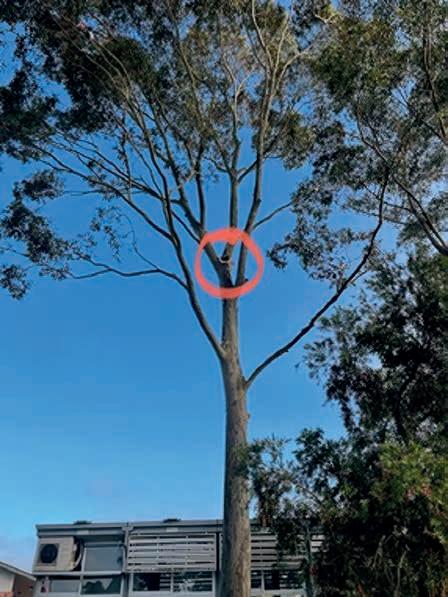
This is too large a topic to cover here, but it’s documenting typical responses and gradations of affectation, localised to decimated including termite activity and live-pest examination. Introduction To Australian Insects by Phil Hadlington has a good range of the basic tree animals and is useful for identification. The CSIRO also has good information on biosecurity issues of pests and whether the tree is toxic or hosting toxic animals, (Poisons website & McArdle D&J (92022) Tree Management Guidelines – TCAA).
Plant-growth regulators Auxin, Cytokinins, Gibberellins, Ethylene and Abscisic acid are determined using reverse-phase chromatography-tandem mass spectrometry. In other words, it’s likely a chemist is needed for this type of testing. These chemicals affect aging, colour enhancement of fruit, flowering, rootgrowth, prevention and promotion of stem elongation ,preventing leafing, fall or both ,distortion and killing of organs.
Fauna tests are an ecological requirement where nocturnal animals may be photographed, or special ecological cameras can address habitation of the fauna in trees. It’s not necessarily an arborist test, but the arborist should know if creatures are residing or dwelling in a tree, for the safety of both the arborist and the animals. Core Koala Habitat under SEPP 44 is an assumed locality for these tests, connectivity or threatened species habitat for conservation should be tested.
Ref:Espade.website
• PH test: indicate soil pH.concentrations of hydrogen (h+) ions for acidity or alkalinity.
• Compaction test: using a probe or gently walking over the surface to determine porosity,’ sounding with feet’ to determine pockets of air or density of material. Note whether vegetation around the area – thriving or surviving?
• Soil/air test: place a ped into a beaker of clear water. Note the bubbles of O2 present over time. (Soil/water see ‘moisture test’).
• Texture test : hand rolling and determining the percentage of clay in soil and sand.
• Specifications for non-destructive excavations: Land slippage and whether the trees are on ridge or valley and whether moisture is easily found here
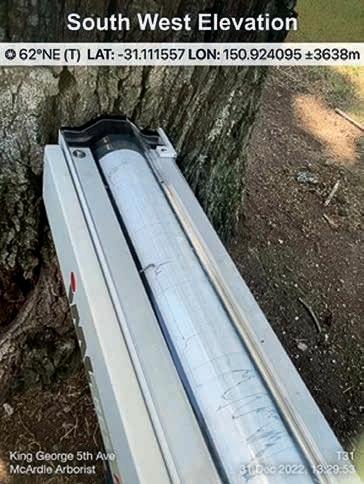


• Less than 3000psi depending on wood type. Melaleuca spp. 2000-3000psi, Eucalyptus spp.1000-2000psi
• No direct contact with roots (greater than 20mm) with spray.
• No hammering with the hydraulic wand.
• No greater than 30% of soil lifted for stability. In sand the roots will spread and sink until they hit the water table. In clay they will fan out and alter direction to where either water is saturated or air space is degraded.
• Induct the ‘hydraulics team’ to the scope of the work and zone of influence, utilise any natural features that may protect observers from flying material in the air and water-soil spoil or add protection.
• Mark uncovered roots with an organic non-toxic compound to present in photos.
• Utilise measuring tapes and photos with the best available light.
• Natural soil or overburden (fill): look for disturbed material that would suggest previous works – fill or dumped builders’ waste, for example.
• Inspect and view at depth 600-700mm depending on soil-profile conditions.
• Utilise three samples at depth 700mm into the SRZ and TPZ interchange.
• View weight/mass of tree and where its main anchorage compression and tension roots are located. Identify the root flanges.
• Soil-drill profile measurements, photograph and tabulate data.
(Ref: Bureau Of Met)
Landzonings and biodiversity values where they overlap in environmental protection E1,E2,E3 and W1 waterways.
• Target test: view the exposed area and prevalent wind direction.
• Slope: note gradients and the response of vegetation. Measure angles.
• Moisture availability in soil, air or on a grade can be measured using an electric hydrometer, observation or both. Large eucalypts can uptake 400 litres per day.
• Which species are hydrophilic/phobic.
Note the distribution of naturalised versus weed populations replacing endemic. Is the tree widely found in the region and state and nation?
• Filtration of particulates from an exposed surface or testing fabric may yield resultant heavy metals, dust or other particulates. Tree protection has modified fencing from AS4970 2009 Tree Protection on Development Sites; so shade cloth is used on the panels to reduce particulate contamination on trees.

• Vibrational monitoring and sonic monitoring: frequencies where leaves are affected. Using traffic-monitoring data for trees near roads or other influences, and utilising dataloggers for measuring frequency of patterns.
• Light and shade: trees are notorious for filling sunny gaps, and growth over the past two years has been constant growth due to plenty of moisture. From a test of suitability, will it tolerate the low-shade environment if building is coming near the development? The arborist would be required to make note of this. Will it tolerate reflected light and the increase of radiant temperatures off a new fence or hard surface? I found, on a hot day, temperatures were exceeding 50 degrees reflected from surfaces, and the only thriving plant was a Bouganvillea spp. .A lux metre has been utilised for the measurement of light. Radiation in the Australian environment is an issue for plants which needs further study.
• Trees with cultural value from indigenous, first-nations peoples.

• Birthing trees: this may require permission of elders or local indigenous communities.
• Scar trees: usually very old and include axe marks or chisel marks.
Memorial trees
• May have some special marking, celebratory ribbons or connection with people today in assisting with remembering enduring characters or history. Isaac Newtons Apple tree, Robin Hoods Oak Tree and near home Ned Kellys tree or The Prison tree WA. • Bordering on heritage uses.
Review both:
1. First source an interview with people like the local librarian, institutes and peoples.
2. Secondary sources include turning to history and newsletters, newspapers etc.
The celebratory effects trees have on our lives needs further study. The
smoking ceremony of indigenous people is of course burning segments of gum leaves. The connection to the spiritual is profound and the trees are a bridge to this practice.
What monetary value does the tree maintain? Refer to Peter Thyers
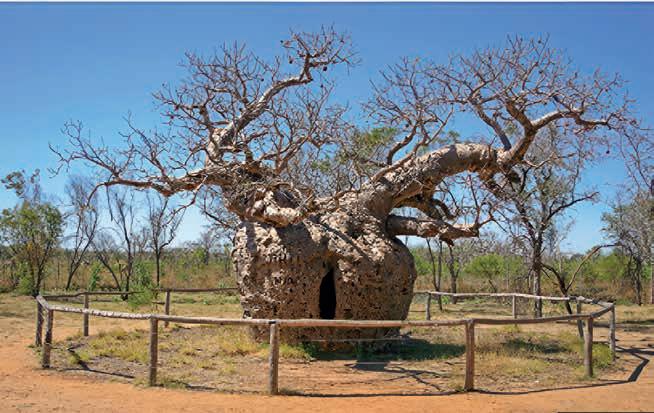
Tree Radar Australia uses a ground penetrating Radar Unit to provide the only, completely non-invasive method of tree decay detection and tree root detection available in Australia.
TREE RADAR UNIT™ DECAY DETECTION.
Tree Decay is a severe problem which can put all the structure around a tree at risk. With Tree Radar Units™ decay detection, Tree Radar can scan for decay in any tree regardless of its height. The Tree Radar unit can give an accurate read out of the severity of decay in a tree without having to penetrate the Tree’s surface.

TREE RADAR UNIT™ TREE ROOT DETECTION.
Tree Radar Unit™ can detect and establish the root proliferation of a tree, this allows the arborist to inform developers of any structural or instability issues without the need for drilling or digging.

methods, including the Burnley Method of Tree value, 1999 draft at ‘Treenet’. The mathematics of using three assessments and finding the average cost may be beyond the ‘normal Joe’ calculation, like using the structural formulae of the SRZstructural root zone.
Is the tree part of the biodiversity area? is it triggering flora/fauna assessment? Does the tree require costing for the BDAR?
An ecologist may assist on the cost of the affected vegetation part. On sites where bushfire management requires the removal of certain trees in a biodiversity area which was nominally protected, a monetary cost is paid for removing the affected trees.
Is the business on the scale of morality for retention of trees? Or is the move toward infrastructure at any cost? It’s
essential the green-culture balance is ethical. Bruce smith, TCAA Secretary and Level 5 consultant from Orange, will discuss ethic in detail in the next article.

This can be where resident action groups highlight more value or more protection. It’s a driver in many developments, particularly if the objections or comments can be viewed when the issues are aired in council or court. Trees which have Today Tonight status, or become a political tipping point, are also where the arborist can be a negative contributor, where the message or communication is misconstrued. Unfortunately, the quotes are in the public domain for the life of the case.
This is an important issue when considering crime statistics of an area and the role the site offers. Is the tree near a school fence or doorway? Is the tree blocking the view of oncoming
traffic? Is it able to hide multiple criminals? When I was in Sherwood Forest in the UK I found Robin Hood’s Quercus sp. Oak tree. It was a rather branched tree which would offer a small vantage point for shooting arrows.
Are we moving towards carbon credits, healthy living trees, growth, expansion and areas suitable for trees to thrive?
Answers to these questions are becoming required for development and reading legislation and reports from Geotech, Hydraulic, Biodiversity, Bushfire, Wind effects and Solar effects reports.
Testing other communications from previous investigators whether tree workers, environmental scientists or arborists statements. This may require communication to previous arborist or the person who made comments that would support or refute the current scope and investigation. Many AQF level 5 reports may be issued over an environmental scientist as these are

not usually accepted as Arboricultural reports in council.
Testing ownership even if a tree is on the boundary or has a portion of a root zone within the adjacent site. Surveys are particularly useful for this stament and proven ownership is preferred.
Finally, with the personal issues the arborist has to take on – being time-poor, the distance to the site, accommodation arrangements and so forth – is it viable for the arborist when other work is urgent? Can a local arborist be found? Given the skills shortage and workload of the level 5 practioner it’s important for arborists who consult to get enough rest.
In the 1980s only a very small proportion of arborists consulted. Most did other tree surgery or gardening works, including pruning and removals. The workload picked up with schools requiring assessments, in 2014 the10/50 bushfire planning and the change in legislation for arborists to
submit reports with DAs. Since then the consultant has been loaded up and the workloads are arduous. Today the consultant arborist has the ‘stretched role’ of testor or assessor fitting into areas like; project manager, political commentator, researcher, valuer, riskand-health assessor, a tree surveyor and plans for yield and quantity-costings expert for works.
Among all this we have leading industry arborist experts who have worked in the field and offer experience and can communicate it. This is the last of this series of articles and I hope it’s been an enjoyable read on: Trees on dam walls, Lightning strike, Proactive tree risk, Training Days, Pre-DA Assessment and Impact, Technical articles on roots, Eco arborist and finally Arboricultural tests.
The TCAA has a report-writers’ day on the May 20. If you wish to attend, call me.
Jim McArdle Consulting ArboristBIBLIOGRAPHY
– CSIRO Boland et al Forest Trees of Australia; Nelson University Press. Australia: 1984.
– Crossing, H, King, M & McArdle, J (2023) Eco-Arborist. Arbor Age, February-March 2023 Australia.
– Hadlington PW. and Johnston IA. 1983. Australian Trees. Australia: NSW University press.
– Hadlington PW and Johnston IA. 1983 Australian Insects. Australia: NSW University press.
– Lonsdale, D, 1999, Principles of Tree Hazard Assessment and Management, Forestry Commission, London.
– Mattheck, C & Breloer, H 1994, The Body Language of Trees – a handbook for failure analysis.
– McArdle, D & J (2014 ed. 2022) TCAA Tree Management Guidelines, Best Industry Practice, Australia.
– McArdle, J (2022) Root Systems. Arbor Age, Oct-Nov 2022 Australia.
– McArdle, J (2022) TCAA Training Day. Arbor Age, August-September 2022 Australia.
– McArdle,J (2023) Eco Arborist. Arbor Age, FebruaryMarch 2023 Australia.
– King, M & McArdle, J (2022) Pre-DA Assessment Reporting. Arbor Age, June 2022 Australia.
Websites
– åaboriginalincursions.com.au › smoking-ceremony
– azolifesciences.com›news›
– environment.nsw.gov.au/research-and-publications/ publications-search/aboriginal-scarred-trees-innew-south-wales-a-field-manua
– firstpeoplesrelations.vic.gov.au › fact-sheet.
– legislation.nsw.gov.au/view/html/inforce/current/ epi-2006-155a
– movementandplace.nsw.gov.au/place-and-network/ built-environment-indicators/tree-canopy
– poisonsinfo.nsw.gov.au
– tcaa.com.au
Designed & manufactured in NZ with local parts & servicing available throughout Australia. 250 hour service intervals, double sized blades and supreme performance for happy customers.

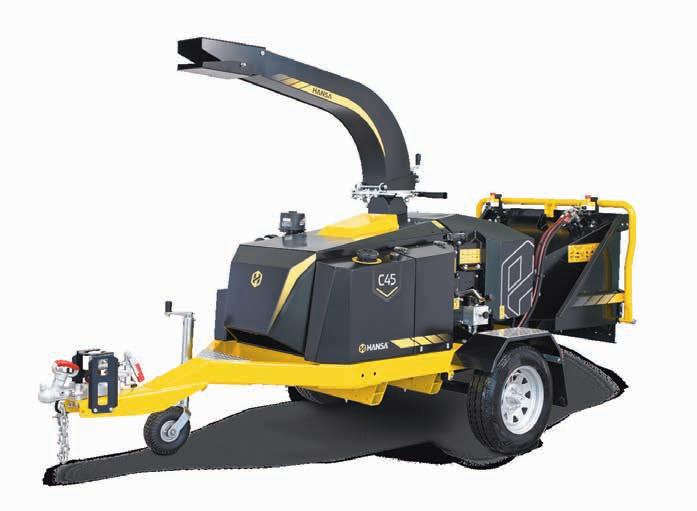
As the association representing arborists in Queensland and northern New South Wales, it’s the QAA’s mission to provide support and guidance to the arborist industry and our members. That’s why, when we were recently approached to give feedback on the draft profile for arboriculture workers, we jumped at the chance to have our say.
The Australian Skills Classification, based on the Australian and New Zealand Standard Classification of Occupations (ANZSCO) produced by the Australian Bureau of Statistics, helps define the skills that underpin jobs in Australia. The Classification identifies three types of skills for every occupation: specialist tasks, technology tools and core competencies.
Currently only one classification, Arborist (362511), exists for our industry. ANZSCO is looking to introduce two new profiles: Arboriculture Workers (3625) and Tree Worker (362512). After consultation with the QAA Executive Committee and members, the QAA provided a range of feedback relating to the occupation titles themselves, as well as the core competencies and tasks outlined. In short, our recommendation was there is much more work to be done before what has been proposed comes close to being a genuine reflection of the arboricultural industry.

We’ll see whether this feedback is taken on board or not and will keep you updated should anything else be put forward.
Six climbers are preparing to represent the QAA at the APTCC in Singapore from April 27 to 29. QTCC 2022 Champions
Jamie Boston and Jess Hamer will be joined by Terry Boston, Shay Williams, Seb McDonald, and James Morris. All were selected as a result of their performances at QTCC.
The winners of the APTCC will represent the Asia-Pacific region at the annual International Tree Climbing Championship (ITCC) held in the US in August. We know Jamie, Jess, Terry, Shay, Seb, and James will be great representatives for the QAA and we wish them all the best for the upcoming competition.

As a not-for-profit association, the QAA couldn’t do what we do without the support of our wonderful sponsors. Sponsorship sales for the 2023-24 year, which come into effect from July 1, are now open, with packages sold on a firstcome basis.
If you are interested in learning more
For info call QAA on (07) 3821 1488, email office@qaa.net.au, or visit www.qaa.net.au.
Follow us on Facebook (QueenslandArboriculturalAssociation), Instagram (qaa_arborist), and LinkedIn (queensland-arboricultural-association) .


about becoming a QAA sponsor, you can request a Sponsorship Package by emailing office@qaa.net.au.
To view more information about any of our events and to book tickets, visit the Event Directory on the QAA website.
In 2023 and early 2024, experienced trainer Bryan Gould is running a series of workshops covering a range of treerelated topics. We know times are tough and committing money to training can be a challenge, which is why we are offering discounted bundle rates to attend more than three workshops. Businesses are even able to book a bundle rate and send different people to different workshops.
The next two workshops – Tree Assessment and Tree Risk Assessment – are both part of the Bryan Gould series. All workshops in this series are suited to aspiring or experienced arborists working within the industry, and information is complementary and supplementary to AQF certificate/ diploma studies.
To learn more and book a bundle rate, visit qaa.net.au/bryan-gould-workshopbundle/. Bundle rates are not able to be booked from individual event pages.
On Friday, April 21, Bryan Gould will provide an overview of essential aspects and approaches to professional tree assessment during three progressive
sessions: Tree Structure and Function; Tree Nomenclature and Taxonomy; and Tree Assessment at our Tree Assessment workshop.
After completing this workshop, attendees will be familiar with defining tree biological processes, understanding tree nomenclature/taxonomy, and linking these factors into a practical and/ or written tree assessment.
During this workshop on Monday, June 5, Bryan will give an overview of key points and principles concerning professional tree-risk assessment. The workshop will consider the contents of the AA/NZARB MIS501 Tree Risk Assessment document. There will be three sessions presented across the day:
* Tree Risk Assessment and Methodology - Introduction to Tree Risk Assessment, Terminology, and Risk Thresholds
* Tree Risk Assessment Components
- Assessing Targets, Tree Failure, and Impacts
* Tree Risk Assessment Extent and Scope - Context of Tree Risk Assessment, Providing Advice on Tree Risk, and Competency to Perform Tree Risk Assessment.
After completing this workshop, attendees will understand the principles of how to approach and undertake a tree-risk assessment that incorporates key factors and provides meaningful information to an agency or client.
It was a full house for our Tree Protection
on Development Sites workshop with Mark Hartley from The Arborist Network on February 28, and attendees didn’t leave disappointed.

Mark looked in-depth at the AS 49702009 Standard (Protection of Trees on Development Sites) and provided many useful insights and tips on a range of topics including tree roots, the ability of trees to withstand damage and the impacts of development, and the benefits of using green mulch.
Hot on the heels of the Tree Protection on Development Sites workshop was the soldout QTRA (Quantified Tree Risk Assessment) training, which took place at the QAA Head Office on March 2-3.
Attendees of the two-day course are now registered users of QTRA and can apply established and accepted risk-management principles to tree-safety management. Thank you to those who attended and to Mark Hartley for delivering the training.
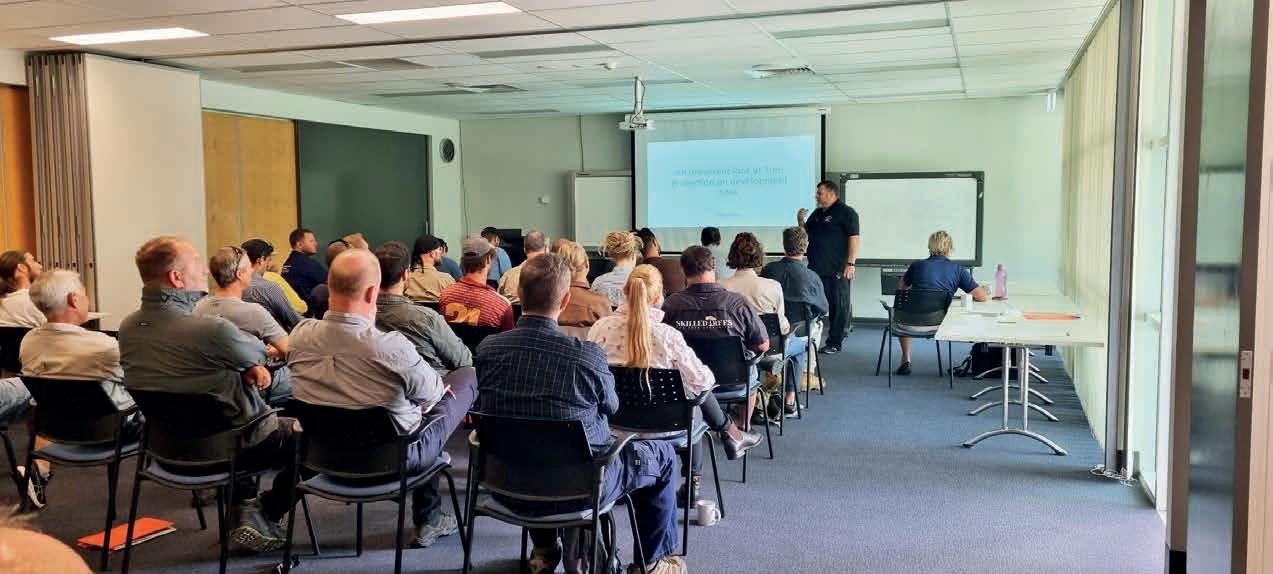
On December 22, 2022, a Full Bench of the Fair Work Commission issued a decision to insert a new model clause into 78 Modern Awards regarding leave during shutdowns (‘the Decision’).
The Decision was made in the ‘plain language proceedings’ as part of the continuing four-yearly review of modern awards which commenced in 2014, and it affects 78 Modern Awards which already contain shutdown provisions. Modern Awards which may be of interest to tree contractors are:
• Gardening and Landscaping Services Award 2020
• Electrical, Electronic and Communications Contracting Award 2020
• Timber Industry Award 2020; and


• Clerks—Private Sector Award 2020.
Many Modern Awards currently contain clauses that permit an employer to direct employees to take annual leave during a shutdown period. Typically, under the current clauses, an employer must give employees a minimum of four weeks’ notice of their intention to do so. In addition to this, some Modern Awards further permit employers to direct staff to take unpaid leave during a period of shut down if the employee does not have sufficient annual leave accrued to cover the shutdown period.
Under the new model clause, an employer may only direct employees to take annual leave during a shutdown period if the employer provides 28 days’ written notice of a temporary shutdown period (although a shorter notice period can be given by agreement between the employer and the majority of affected employees). Notice must also be given to any employees who are engaged after the date notice was initially given to other staff.
If notice was given, then an employer may direct employees to take accrued annual leave during the shutdown period. The direction must be in writing and must be reasonable (including in relation to the length and frequency of shutdowns).
The model clause will replace any existing clauses on the matter in each affected Modern Award.
There will, however, be adaptations to the model clause in various Modern Awards to incorporate existing prescriptions which:
• Limit the application of shutdown provisions by reference to the circumstances in which the shutdowns occur (such as restrictions relating to the time of year during which the shutdown occurs and the purpose of the shutdown, ie: shutdowns may be limited to the Christmas/New Year holidays, and/or may be for the purpose of pre- planned maintenance); and
• Prescribe a notice period of longer than 28 days for a shutdown.
In its Decision, the Full Bench concluded a direction to take unpaid leave during a shutdown is, in substance, a ‘standdown’, and modern awards are not permitted under the Fair Work Act 2009 (Cth) to contain such terms. Accordingly, the amendments will remove/replace modern award provisions permitting an employer to direct an employee onto unpaid leave during a shutdown.
Under the amendments, an employee with insufficient accrued annual leave may take annual leave in advance during a shutdown in accordance with an agreement under the relevant Modern Award terms. Where there is a shutdown which is not the subject of a direction to take leave, an employer and an employee may agree in writing for the
employee to take leave without pay.
In relation to the implications of the amendments (and in response to concerns raised by employers), the Full Bench indicated1:
1. In some circumstances, a shutdown may be due to circumstances which qualify for standing down employees (unpaid) without needing to rely on modern award terms.
The Full Bench gave the following example: “In the building industry, if a head contractor closes down a building site over Christmas/New Year, that is likely to cause a stoppage of work for which a subcontractor employer cannot reasonably be held responsible and thus enable [an unpaid] stand down under s524.”
1See [69] – [70] of the December Decision.
2. Employers may manage annual-leave requests (including reasonable refusal of requests under s88) throughout the year so employees have sufficient accrued leave to cover a shutdown period.
The Full Bench stated “...where it is an established feature of an employer’s business, or a relevant part of it, to shut down in the Christmas/New Year period, it would be unlikely that a refusal to agree to a leave request which would leave the employee with insufficient
accrued leave to cover the shutdown period would be unreasonable within the meaning of s88(2) unless there were some strong countervailing factors pertaining to the individual concerned.”
3. Employers may manage shortfalls of accrued annual leave in other ways, including (where applicable), use of accrued rostered days off, TOIL, or granting requests to take annual leave in advance.
4. An employer could identify useful work that could be performed in a part of its operations by employees who do not have sufficient accrued annual leave to cover all or part of a
shutdown, and who do not agree to take leave without pay, provided the work is within the terms of relevant modern award provisions dealing with employer and employee duties.
The Decision states that the variations will take effect on May 1, 2023. Please contact TTIA if you have any queries with regard to the above. TTIA will be running seminars in the first half of this year dealing with this and any other substantive industrial relations/award changes.
After a forced interruption during the COVID period, TTIA will be resuming our popular Member Briefing sessions in May/June of this year in locations throughout various States. We will be dealing with many substantive industrial relations/award changes, including those as a result of the change of federal government last year.
Tree contractors are invited to access details of venues and dates by phoning the TTIA Hotline on (02) 9264 0011, or emailing ttia@ttia.asn.au, and will receive a special discount should you wish to attend any of the sessions.


Plenty of companies, both small and large, struggle with the admin side of business.
Arborists usually want to be out and among trees and customers, and find the process of compliance and business development difficult, or at best timeconsuming. Searching for work, quoting and chasing up proposals can be difficult too.

There’s a company which specialises in helping arborists and tree-service companies deal with such matters, and right now that company, Enviro Trees, is going through amazing growth.

Based in Sydney’s north, Peter Dubiez had been in the tree industry since 1985 and in 2005 decided a break would do him good. After five years he realised how much he enjoyed working with trees and in the tree industry in general, and in 2010 he and his wife bought a small arbor outfit called Ace Tree Services. It was rebranded to Enviro Frontier, and now in 2023 is Enviro Trees.
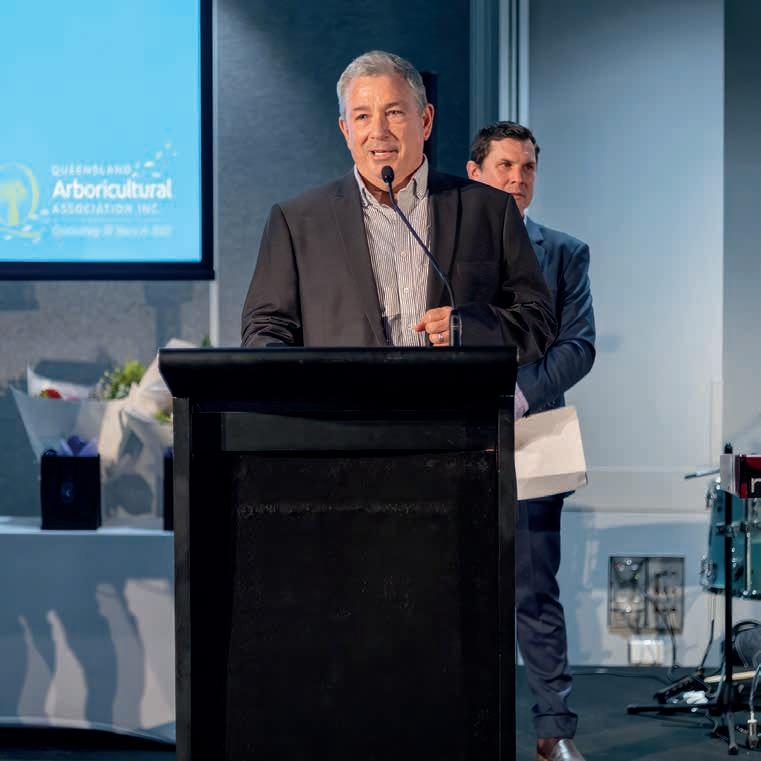
In 2011 Peter saw an opportunity. “We were doing storm work, and I thought, ‘Why not give a decent marketing document package at the
end. One with before-and-after photos, customer sign off, the names of the staff who attended, the registration of the trucks and chippers…the whole lot’.
“It was the first time the insurance industry had actually seen a package like that, with transparency in the work undertaken and the cost. They were really impressed, and they said, “Well mate, no one else is doing it. Is it something you think you could do a bit further afield than in just your local area?”
That was start of the journey which led to Peter speaking to The Australian Arbor Age from Manchester in the UK where he has set up a British branch of the business, Enviro Trees UK, which is already undertaking subsidence tree works –a business already well established in Australia with satellite offices in New Zealand and Spain.
He’s certainly moved outside his local area.
In 2013 Peter began developing software he called Tree Manager.

Enviro Trees was receiving increasing requests for crews to travel to rural and regional areas of the country, placing a strain on the city-based team. Armed with 30 years’ experience and with the help of technology, he set about building a national network of first-class tree partners which could be accessed quickly and reliably through one easyto-use online system: Tree Manager.
“It’s software that allows us to act as a project manager or aggregator for works that go through the pipeline,” explained Peter. “Our initial course was supporting the insurance industry for emergency works. Now our focus is on ‘regular’ maintenance work –housing commissions, public schools, government and council contracts and so forth – and we were able to win a lot more of that work nationally.
“But the beauty of it was we still went back to the local, smaller provider. They
really fit under our umbrella, and they still got the work. Tree Manager allowed them to sometimes beat out the bigger providers.
“Our focus has always been, ‘How do we provide the work and the opportunity to the local provider?’ Most of our tree partners average probably only five to seven staff. They’re really mum’n’dad outfits. They’re on the site with their team. Over the years we’ve seen many of our tree partners’ businesses double and triple in size.
“It’s simply because we can deliver regularity of revenue, and we help them with compliance and documentation.”
Whether it’s routine pruning, stormdamage assessment, or complete tree removal, Enviro Trees helps arbor businesses get the work done quickly and safely, with accurate pricing and reliable documentation.
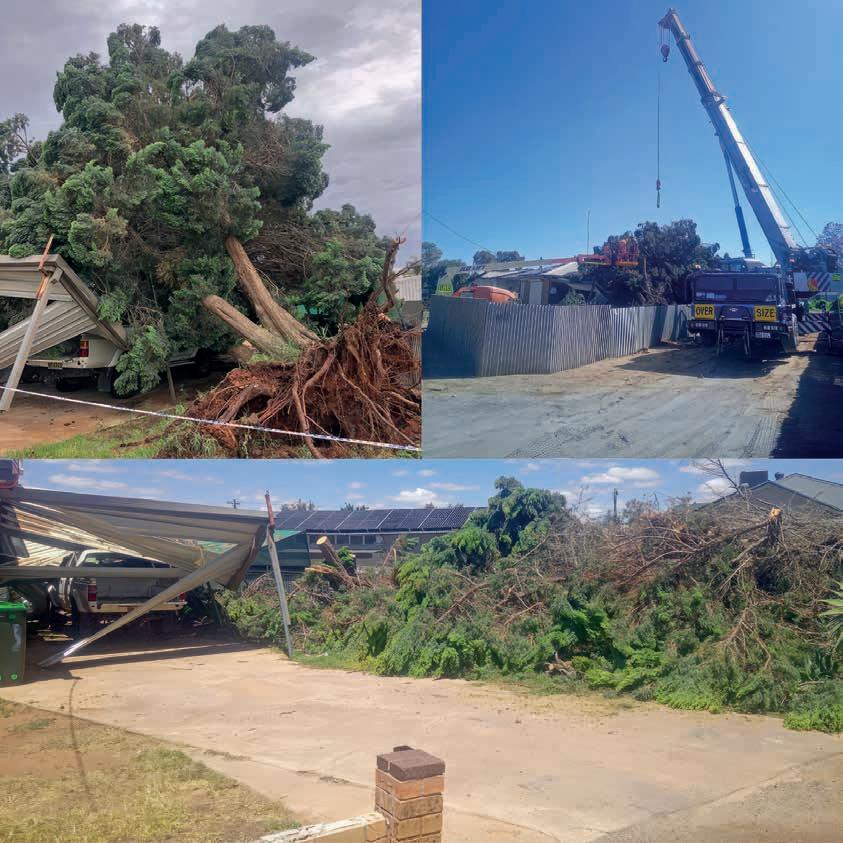
The company uses the innovative workflow platform, Tree Manager, to manage the entire process, from allocation through to completion.
It’s fast, reliable, and gives instant access to real-time information – like the scope of works, photographs, and costs – anytime they’re needed.
Owners, builders, government and commercial clients rely on Enviro Trees for clear communication and secure management of their tree works, performed by pre-qualified tree partners. With set-rates and quality data reports, Enviro Trees has become the number one choice for insurers in makesafe and tendered tree works nationally.
With things going so well at home, a general manager and executive team was put in place in Australia and Peter up-stick to kick off overseas.
“One of our main providers in Australia, a major global loss adjuster, Crawford, recommended we have a look at the UK, just because of the method and what we’d achieved in Australia,” said Peter, his eyes shining, “and look, it’s exciting!
“At 60 I’ve been reminded why I got into the tree industry in 1985. I’m meeting a whole group of different tree operatives, and it’s incredibly revitalising and energetic to get out and see all the tree owners and staff again.
“I’d become a boring old fart who’d been sitting behind a desk in Sydney for too long,” he chuckled. “Now I’m actually out and in amongst ’em, communicating with other arborists, meeting with them, and it’s incredibly refreshing and exciting.”
What does the future hold for Peter and his fast-growing endeavour?
“My focus now is clearly here in the UK, duplicating what we’ve done in Australia, and it’s a different work environment, being the subsidence market which we don’t really have in
Australia. It’s a phenomenal group of tree companies over here. They’re far more fixated on training their staff than in Australia. Every staff member here would have four or five tickets. But they only use little six-ton trucks and little sixinch chippers, so it’s completely different to Australia, which has 20-inch chippers and heavy trucks.
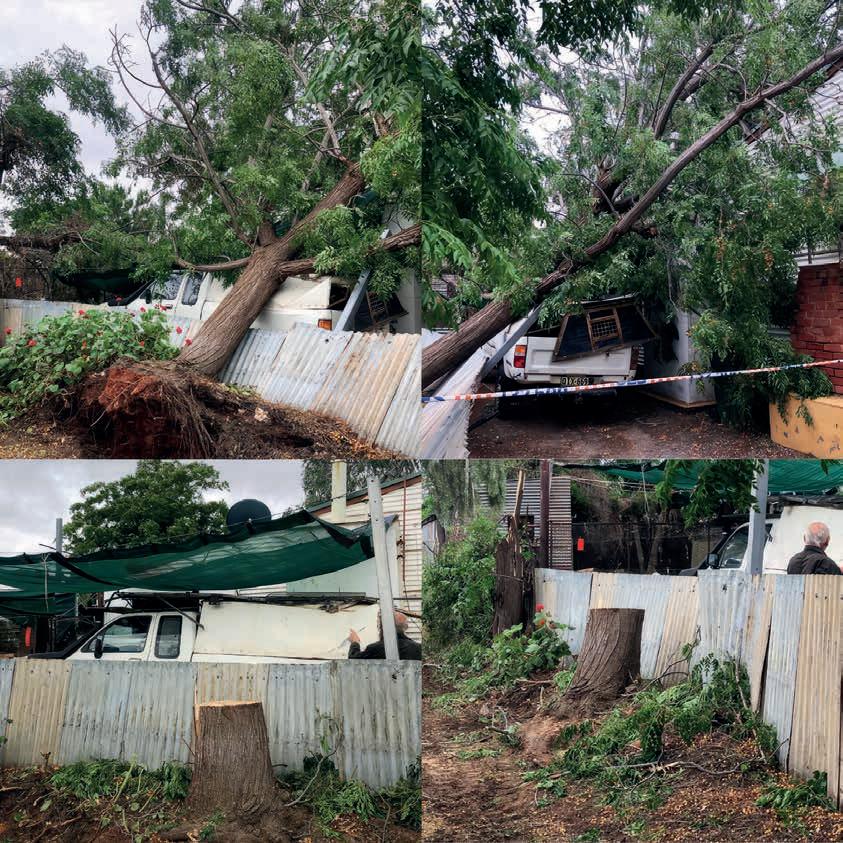
“They’re very focussed on staff training here, and that’s something we need to duplicate in Australia.”
“And then we’ll see what happens when I get to 64 (laughs).”
“Look, I’m just grateful for the tree partners,” said the easy-going ex-pat. “They’re the reason we’ve got where we
“The tree partners we’ve had with us, they’ve gone through the pain. Developing technology’s the hardest thing I’ve ever done. I’d rather climb a hollow tree hanging over a glasshouse than go through building and designing the Tree Manager technology again. And it’s changing so rapidly. Those tree partners, and the current and past Enviro Trees staff, are the only reason we’ve been able to succeed the way we have.
“When you create a network and you collaborate, you can actually grow a lot quicker. Our Enviro Trees ecosystem is about a collaborative group leverage as a benefit. It’s a win-win.”
At Enviro Trees, we are proud of our local first, national approach.
We work with a network of tree businesses (Tree Partners) on the ground in towns and cities across Australia.

From Darwin across to Cairns, down through QLD, NSW, ACT and Victoria, across to Tasmania and through South Australia and into Western Australia, Enviro Trees provides responsive and skilled services to the insurance, emergency services and facility management industries.


Our Tree Partners are able to work in their local communities, managing their jobs via our award-winning proprietary software, Tree Manager™.
timely and safe manner, Australia wide, even in regional and remote locations.
Access to a strong, national customer base often not accessible by other tree companies

Enviro Trees manages all customer communication, invoicing, debt management any disputes etc.

Our national customers value the level of service we provide them across the country, using local tree partners who know their communities, as well as the ability to be flexible and scale up to support them in major weather events.
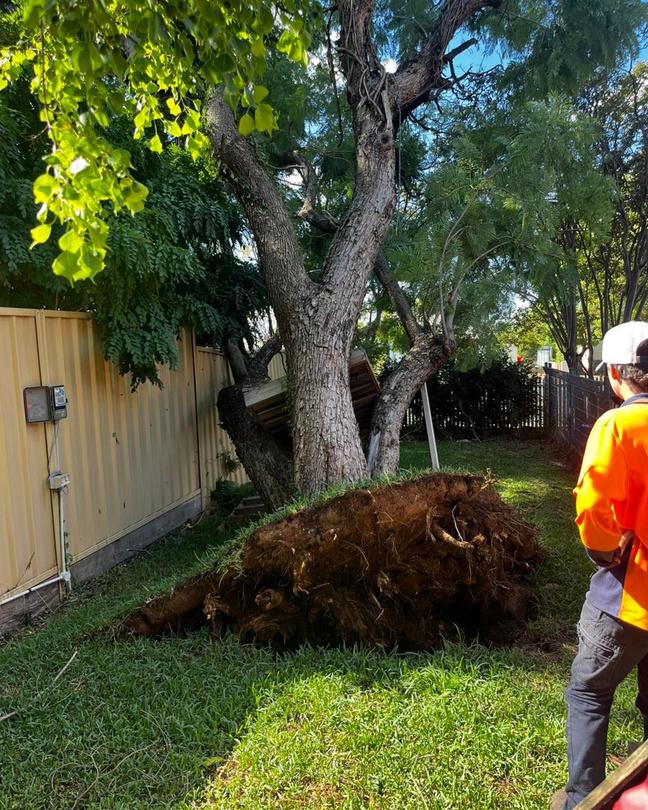
Australia will host the 30th session of the UN Food and Agriculture Organisation’s (FAO) Asia-Pacific Forestry Commission (APFC).
The theme for the October 2-6 event in Sydney is ‘Sustainable Forests For A Sustainable Future’.

The APFC is the Asia-Pacific region’s key decision-making forum for forestry issues.

The biennial event will bring together around 200 delegates and observers from more than 30 forested Asia-Pacific nations to discuss and agree on the FAO work priorities for the region.
The discussions, which will be chaired by Australia, will also provide a regional voice to the FAO Committee on Forestry, which ultimately guides the FAO’s multi-
million-dollar forestry program.
The APFC will provide an opportunity to showcase Australia’s world-class, unique and diverse forestry industry. Delegates and observers will take part in three days of formal sessions and a full-day field trip.
Industry groups, research institutes and visiting nations will also host sideevents over the course of the week, building links between Australian industry and key international counterparts.
It’s the first time in 23 years Australia has hosted the APFC. The 18th session
was previously hosted in Caloundra, Queensland, in 2000, and the ninth session in Canberra, ACT, in 1973. Australia will also host the next meeting of the Montreal Process Working Group immediately following the APFC event on October 6-7. The group’s 12 nations account for 90% of the world’s temperate and boreal forests, and together lead work accounting for and assessing forest trends and conditions.
For more information on APFC 30, visit the FAO website.
Delegates and observers will take part in a full-day field trip.
In March 1949, a Forestry and Timber Utilisation Conference for Asia and the Pacific was convened at Mysore, India. This first inter-governmental meeting on forests in the Asia-Pacific region made a number of important recommendations on future management of regional forests and they expressed a strong desire for a permanent mechanism with responsibility for monitoring progress in the implementation of the participants’ joint declaration.
The Conference recommended the establishment of a Forestry and Forest Products Commission for Asia and the Pacific. The request was forwarded to FAO, where it was approved at the Fifth Session of the FAO Conference in November 1949. The First Session of the Commission was held in Bangkok, Thailand in October 1950.
This position provides technical expertise and advice regarding the management of Ku-ring-gai’s tree canopy.

• Salary $84,744.04 to $98,303.47 p/a + super
• Permanent full time position – 35 hours per week
• Leaseback vehicle offered
About Ku-ring-gai Council
Located 16 kms north of the Sydney CBD, the Ku-ring-gai area covers 84km2, is home to 124,000 residents and is one of New South Wales’ most attractive natural environments.
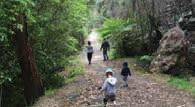
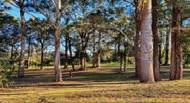


About the role
Council is currently seeking applications from suitably qualified and experienced individuals for the role of Tree Management Officer.
Duties
• Demonstrated ability to conduct tree risk assessment and identification

• Demonstrated knowledge and experience in arboriculture
• Demonstrated experience in a customer service role
• An understanding of local government operations and regulations
• Ability to interpret and apply relevant legislation
• Participate in the gathering of evidence for unauthorised tree works, preparation of statements of evidence and acting as an expert witness
• Demonstrated knowledge and experience in specifying tree work maintenance
Skills & experience
• AQF Level 5 Arborist
• TRAQ or QTRA tree risk assessment qualifications or willing to undertake training
• Current C Class Licence
• WHS White Card
• Certificate 4 in Grovernment Investigations or willingness to undertake trainingtree work maintenance.
Applicants are required to address all essential criteria as listed within the position description to be eligible for an interview.
Like to know more? Contact Greg Narker on 02 9424 0698 Apply at: www.krg.nsw.gov.au/Council/Careers/Current-vacancies Closes: 11:30pm, Sunday 30 April 2023
The APFC will provide an opportunity to showcase Australia’s world-class, unique, and diverse forestry.
Ku-ring-gai Council is an equal opportunity employer
Australian Spider Lift specialists, Monitor Lifts, has recently opened a modern branch in Caboolture on the north side of Brisbane at 2 Alta Road, Caboolture, Queensland, 4510.

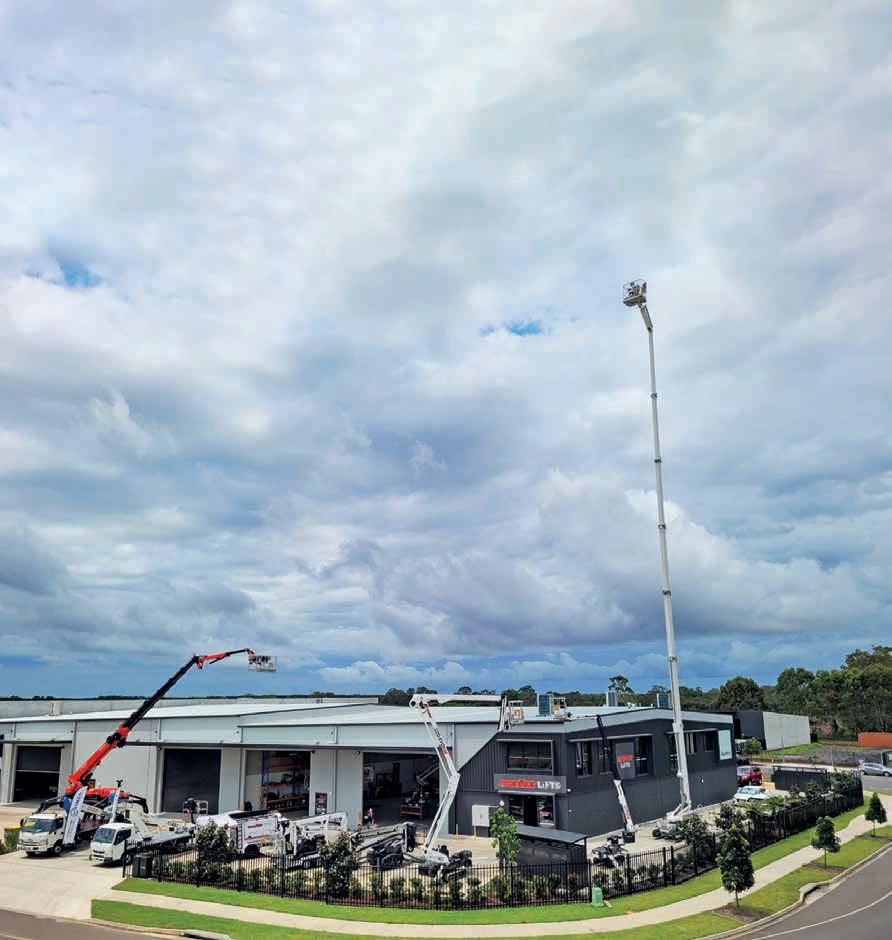
With a great range of products in stock for sale and/or hire, the team at Monitor Lifts Caboolture includes qualified, factory-trained technicians to ensure any machine sold into the Queensland region gets quality back-up support.
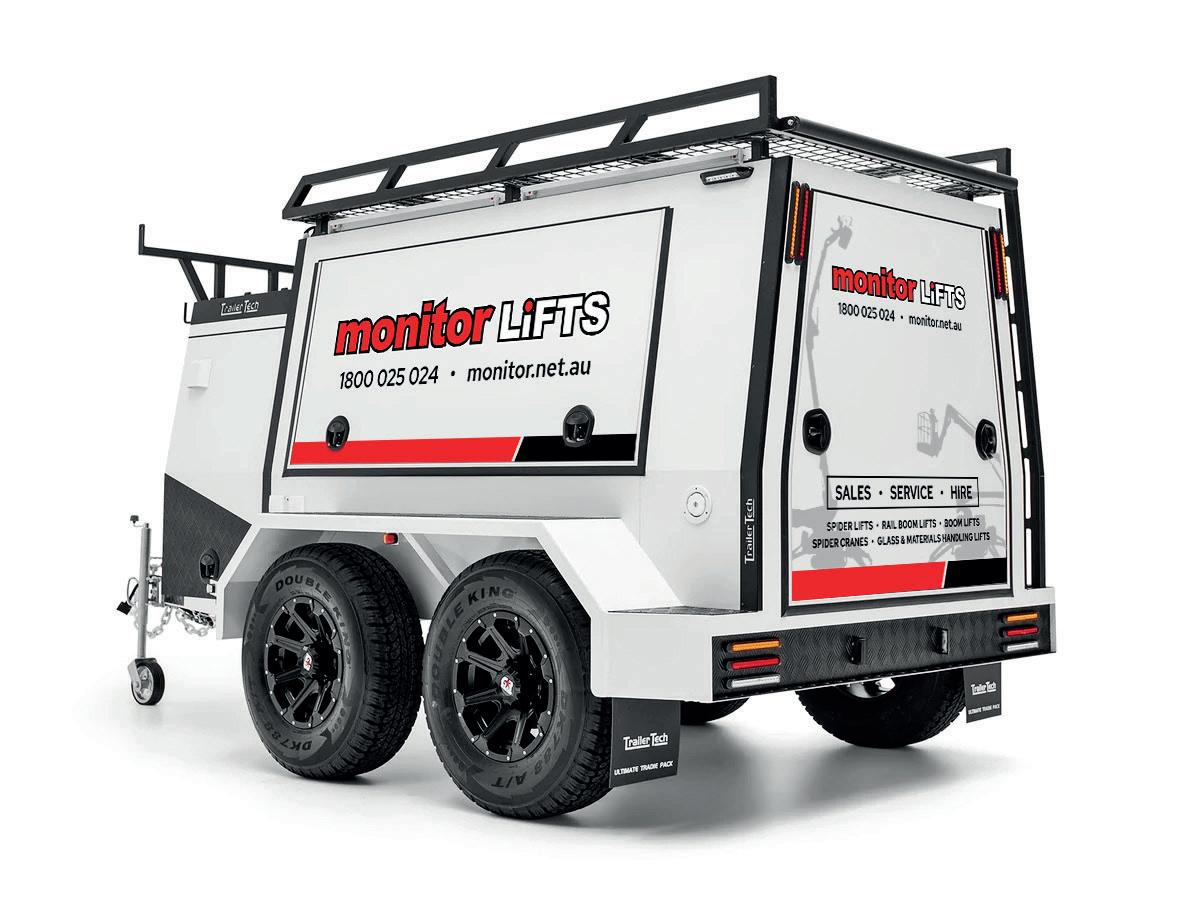
The specialist Monitor Lifts technicians are fully qualified in hydraulics, electrical, and mechanical servicing to keep your EWPs running. Their years of experience mean reduced downtime and increased safety for you and your employees.
Not only is the branch stocked with machines and parts, Monitor Lifts even has one of its new service trailers based at Caboolture for field service across the state. This trailer package acts as a full mobile workshop, complete with generator, solar panels, compressor, oils, water tank, fridge/freezer, shade awning, lighting, tools, spare parts, consumables and more!
The new Queensland branch is a strategic step in Monitor Lifts’ growth
plans, allowing for increased support for its Queensland clientele. Having sold machines across the Sunshine State for over 20 years, there are many happy customers benefiting from this increased resource.
In addition to the Caboolture branch, Monitor Lifts also has a
southern workshop at Acacia Ridge and Crestmead for clients south of the Brisbane River, Gold Coast, etc.
Monitor Lifts’ headquarters is based in Tamworth NSW, other branches include Sydney and Brisbane, and Monitor is committed to opening in Perth, WA, later in 2023.
Monitor Lifts is best known for the extensive range of Spider Lift products in which the company has speciliased for 26 years now.
Monitor offers a wide range of models, ranging in height from 12m up to 43m. The Spider Lifts are designed to be lightweight and compact, and come fully equipped with top-of-the-line features such as radio remote controls and hybrid power options.
Trailer packages are available for all models, and Monitor also has a wide range of used units available for sale.
Monitor Lifts’ 24-Hour Support Service provides the emergency support, spare parts supply, routine maintenance and training you need – wherever you are in Australia.
Monitor provides training when you purchase one of its machines, either in person, via phone, or virtually. If you choose to have your lift delivered by Monitor, it will provide on-site training at no extra charge.
Contact the friendly team at Monitor Lifts now by calling 1800 025 024 or emailing sales@monitor.net.au. Visit www.monitor.net.au to see the full range Monitor Lifts offers.

One of Australia’s leading suppliers of EWPs is set for a huge year.

With a new year comes new beginnings. Like many of us in the industry, Aerial Access is no different and has started 2023 with a bang! New types of some of Australia’s most robust, fit-for-purpose MEWPs hitting the roads, custom builds, containers landing, hybrid/electric units heading into R&D stages, an array of amazing new team members joining the workshops around the country, and taking possession of an additional 5000sqm parcel of real estate in Hobart, Tasmania, where a brand new, fully tailored office and workshop facility build will soon to be in action, just to name a few!

Don’t wait!
While Aerial Access is committed to retaining the highest level of available EWP platforms in stock for Australian cutstomers, it doesn’t come without its challenges. Time Manufacturing USA is transitioning through a substantial growth period of its business with the acquisition of additional manufacturing businesses throughout the world. In excess of 7500 units are either in production or the early stages of production, and the lead times for new units being delivered to Australia has been affected.

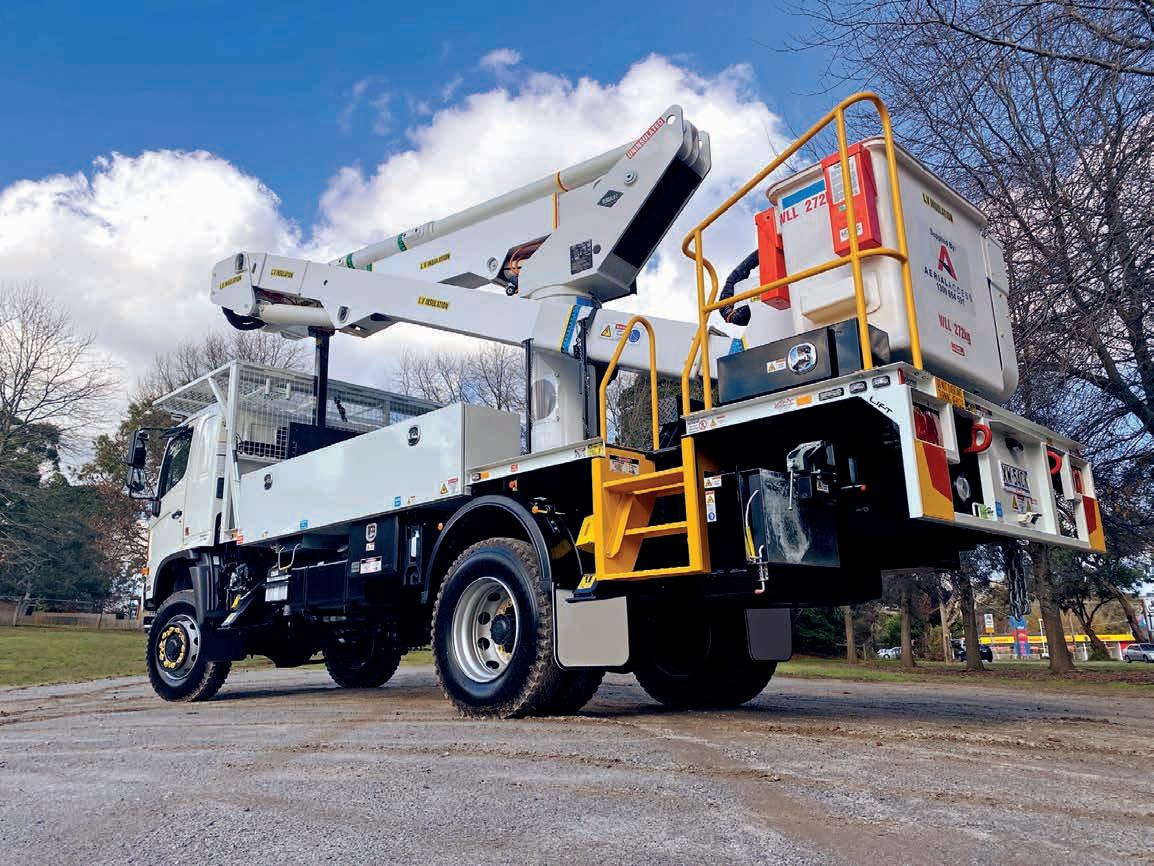
If you’re considering adding a new addition to your fleet, please reach out soon to lock in a spot.
Below:
Manufactured for the Australian market, the Snorkel line of trailermounted boom lifts features a range of capacities and lifting heights along with an array of features to suit a variety of applications. The portability of a trailer mount makes these machines ideal for contractors who work at multiple jobsites.
The Snorkel MHP15HD is a heavy-duty trailer-mounted boom lift that offers durable performance and precision on the jobsite. Rugged and reliable, the MHP15HD is ideal for arborists and can be towed by an SUV or utility.


This compact model features easy jobsite positioning and an outstanding working envelope for up-and-over capabilities, making access to awkward angles and tight spaces a breeze. Its automatic self-levelling capabilities enable safe and versatile work at height.
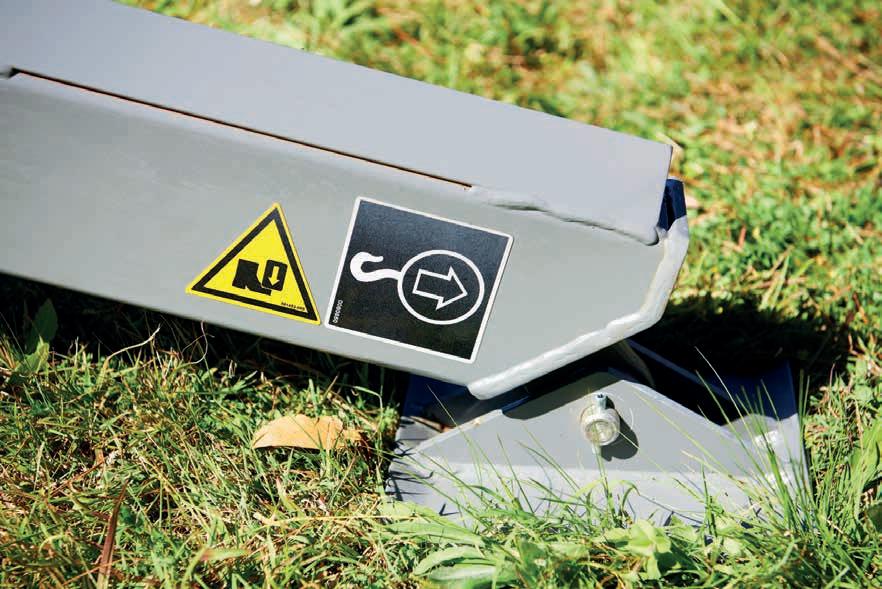
A versatile jib with 140° rotation delivers smooth and accurate precision, while enhanced side-to-side maneuverability provides better access to larger areas without repositioning the unit.
The MHP15HD’s durable two-man steel platform can lift a safe load of up to 200kg up to a working height of 14.8m. Additionally, a 600V AC rated wire platform allows operators to use power tools up high. The MHP15HD is also equipped with fully proportional speed controls for added flexibility. A versatile jib with 140° rotation delivers smooth and accurate precision, while enhanced sideto-side manoeuverability provides better access to larger areas without repositioning the unit. Fitted with a superb 5hp engine, this trailer boom provides reliable performance, while optional bi-energy power offers clean and quiet operation in low-emission environments.

For more information, please call Ahern Australia at 1300 900 700 or visit ahernaustralia.com.au.

Australian Design Verified, CMC aerial platforms are ready to tackle any job thrown at them.

One of the standout models in the CMC Spider Lift range is the S22HD.
With an articulated platform that’s perfect for outdoor work in extreme conditions, the CMC S22HD boasts a pantograph, two-stage telescopic boom, and a jib, making it a powerful and

adaptable machine. Its high levelling capacity outriggers, three working areas, and long horizontal reach are just a few of the features that set it apart from its competitors. Thanks to the multiple travel speeds and impressive working height of 21.6 metres, the S22HD is suitable for a wide variety of jobs.
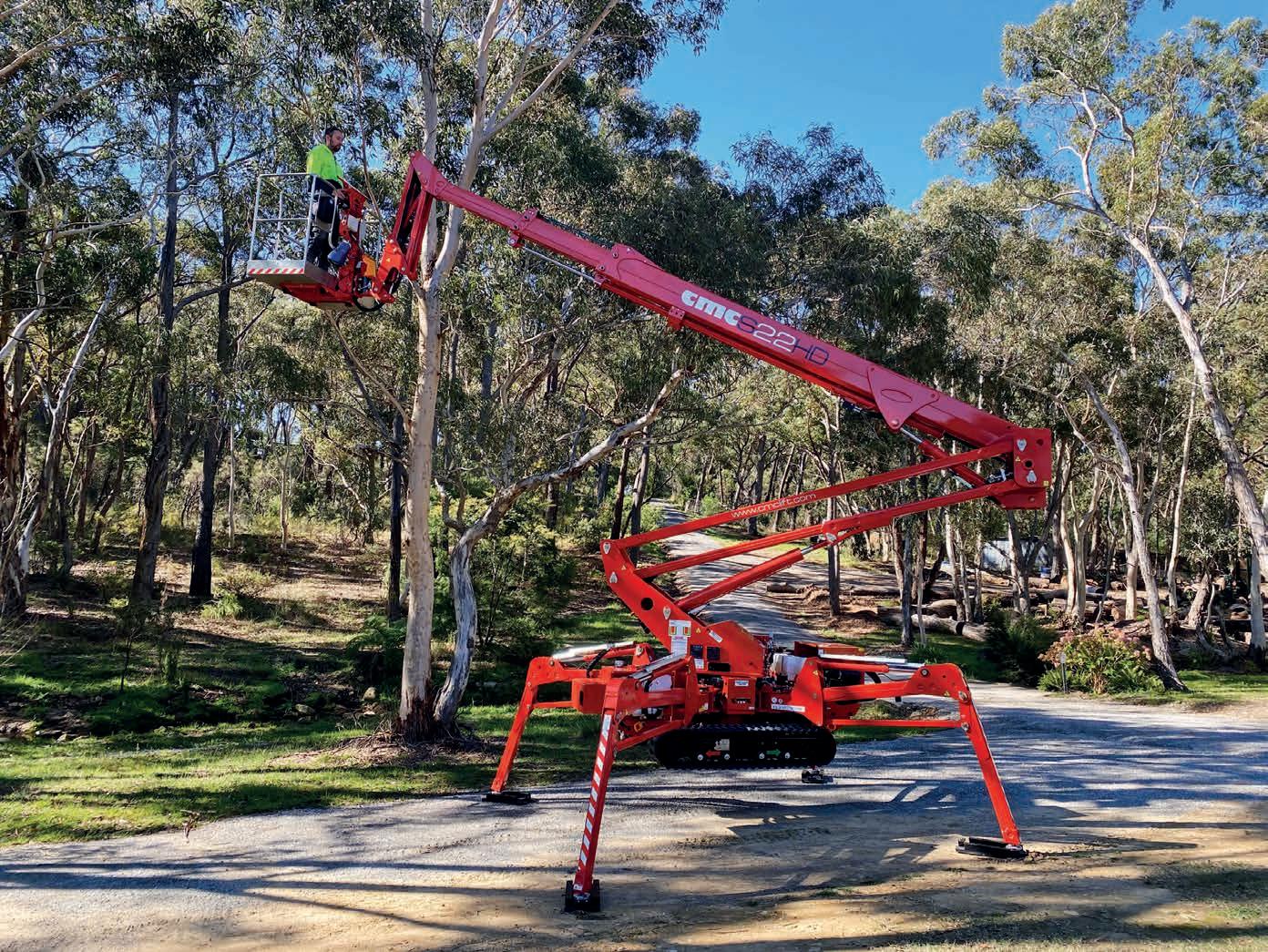
In addition to the impressive S22HD, CMC has introduced the innovative F Series Spider Lifts
This new range of lifts brings together cutting-edge technology and design to provide users with unmatched performance and versatility. The F Series includes the S13F, S15F, and S18F models, each designed to meet specific needs and cater to different job requirements.
The S13F is a compact and lightweight Spider Lift, offering 12.9 metres of working height. It’s designed for use in tight spaces and difficult conditions, making it perfect for various indoor and outdoor applications. The full hydraulic system, two working areas, and telescoping boom extensions make the
The S15F is designed for ease of use and boasts a very high performance. With a maximum working height of 14.8 metres and an outreach of 8.7 metres, this versatile Spider Lift is suitable for any work environment. The compact stabilisation area ensures the S15F is ready to tackle any job, even on the most challenging terrain
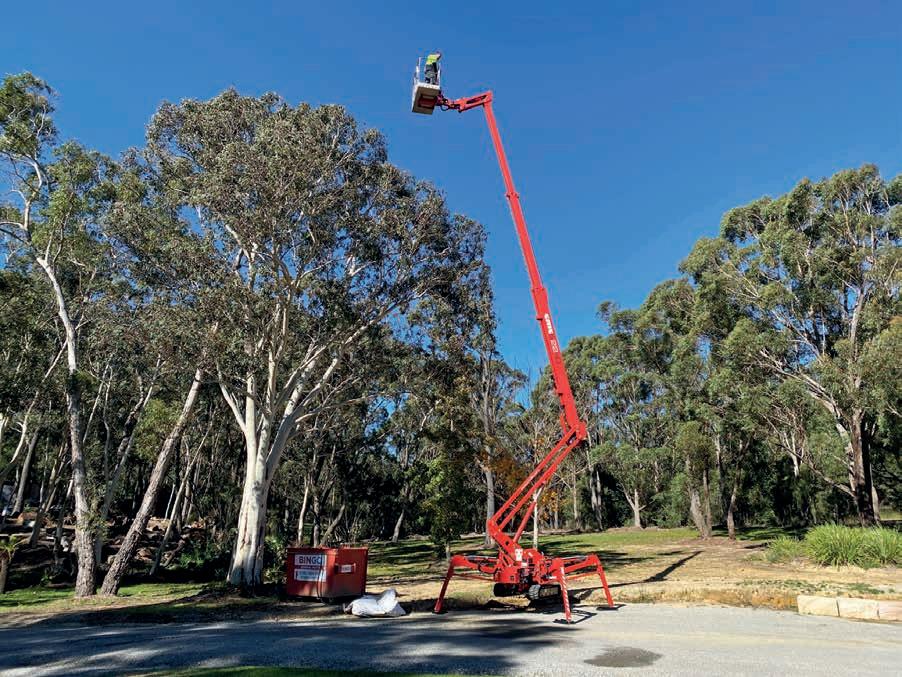

Last, the S18F offers simplicity and reliability in a powerful package. This 17.7-metre Spider Lift features a full hydraulic system, a pantograph, and two telescopic boom extensions, along with an articulating jib. The S18F is easy to use and can be towed on a trailer, making it a perfect addition to any vehicle or equipment fleet.

For more information on the exceptional range of CMC Spider Lifts, including the S22HD and the innovative F Series models, call Global Machinery Sales at 1300 072 926 or visit globalmachinerysales.com.au.





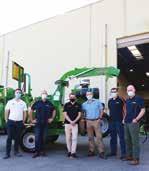


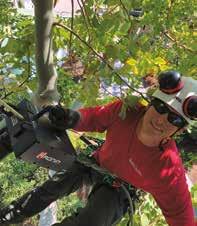







Intermercato
Morbark
Vermeer
Bandit
Först
Vosch and Westtech
Hansa



If you’re lopping and chopping trees, a customised grapple saw is a safer, more efficient way to work. It makes your excavator more versatile and it saves on manpower – a welcome innovation in these times when good workers are hard to find.



An Intermercato grapple saw combines the Intermercato Swedish grapple of your choice with a worm-drive rotator and an Italian hydraulic saw. All components are supplied individually, and Intermercato Australia will mount and install in-house. That means your kit is customised to create exactly the tool you need to blitz your workload this year.


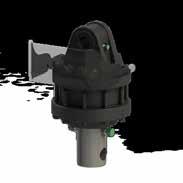
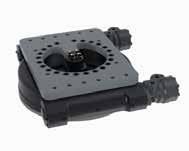

The rigid-mount design is Intermercato’s preferred setup with a worm-drive rotator. This allows you to reach up, grab a limb and operate the saw. Once the limb is cut it will not fall and will be held in the same position. You can safely bring the limb to the ground. Intermercato Australia also has the capability to design and create a pendulum mount.
Most excavators only have two sets of auxiliaries, so a 12V or 24V solenoid may be required to share one of the hydraulic lines.


There are two options. You can share the saw and grab on the same line and leave the rotator on its own line, or you can couple the grapple and rotator on one line and have the saw on the other.
Or you may want to have another feed line installed to operate the saw. To power the solenoid, you will need to install a momentary switch in the cab.

The main setup requirement for the saw is enough hydraulic flow, because your machine must have the correct amount of flow to power the saw’s requirements.
The next most important criterion is the return-to-tank line needs to be at least ¾" or 1" for the bigger saws. This drain line must go straight to the tank with no restrictions apart from a resistance, so a screwed connection is preferred.

There are four hydraulic saw options. The team at Intermercato grapples can advise you on the setup that best suits your needs.

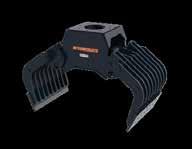
To find out more, contact Robert today on 0436 028 643 or visit grapples.com.au.

Along with its with transport system and some other great associated gear, Morbark’s powerhouse horizontal grinder was unveiled at this year’s CONEXPO-CON/AGG show.

The Morbark Transport Dolly for the Next Gen 6400XT was developed to simplify how customers transport their machines. Equipped with independent air-ride suspension and remotecontrolled front and rear hydraulic locks, a single operator can attach the transport dolly in minutes, eliminating the need for a specialised low-boy trailer.
“The 6400XT is the best in its class
for processing wood and organic waste with power and reliability,” said Michael Stanton, vice president of sales and marketing at Morbark. “The new Next Gen 6400XT, scheduled for fourth-quarter 2023 release, builds on that legacy.”

In addition to the new transport dolly system, the Next Gen 6400XT has undergone a few other updates:
• Enhanced frame design allows for
Transport Dolly attachment while keeping machine width to three metres, providing uniformity for both domestic and other global markets
• Automatic hammermill drive-belt tension system, and
• PT Tech patent pending Hydraulic Torque Limiter provides the ultimate driveline protection while allowing ease of setting adjustments based on grinding application.
Morbark’s powerhouse horizontal grinder was unveiled at this year’s CONEXPO-CON/AGG show.Denis Cimaf, an affiliated Morbark brand and leading manufacturer of industrial mulching and brushcutting attachments, introduced a new line of open-face, carbide-tip mulching heads for dedicated carriers, skid steers, and excavators. The new mulching heads will be known as the Denis Cimaf DX series.


“Using the same durable Denis Cimaf frame customers have come to trust, we’ve developed a heavy-duty rotor suited for harsh environments where it is possible to encounter ungrindable objects,” said John Balogh, director of sales for Rayco Forestry and Denis Cimaf. “In addition, the rotor and motor orientation provides a compact package that creates less stress to the carrier.”
The DXF features heavy-duty carbide teeth that rip through hard and soft wood up to eight inches in diameter, and is ideal for tackling mulching or brush clearing with power and hammer-style force. In addition, it’s well-suited for land clearing, vegetation management, and utility and roadside maintenance in unknown and rocky terrain.
Denis Cimaf introduced a new line of open-face, carbide-tip mulching heads for dedicated carriers, skid steers, and excavators. The new mulching heads will be known as the Denis Cimaf DX series.

Joining Morbark at ConExpo this year was sister Alamo Group company, Timberwolf, from the United Kingdom, which showcased the TW 280HB HYBRID brush chipper.
The Timberwolf TW 280HB HYBRID was developed to meet the growing industry trend toward more sustainable solutions. With a processing throughput of over seven tonnes/hour, the TW 280HB HYBRID offers a class-leading 62 peak horsepower, but only 25HP enginelevel emissions. Simple to maintain, the TW 280HB is ideal for companies and organisations committed to minimising emissions without compromising performance.
Supplementing engine generation power is a power-dense hybrid system.
The Timberwolf TW 280HB HYBRID brush chipper was developed to meet the growing industry trend toward more sustainable solutions.


An Inmotion Generator Synchronous Motor (GSM) and energy-efficient SECH supercapacitors are integral to the system.
Providing swift recharge capability in contrast to Li-ion battery solutions, supercapacitors store and release energy quickly, coping with the variable duty cycle of the arborist’s job. Furthermore, this is integrated into a self-supported system that doesn’t need external charging to operate. As the arborist’s working environment is continuously changing and the work schedule is often long, the TW 280HB HYBRID will perform throughout the day, every day.
“Balancing performance and emissions was a challenge that could not be met by simply dialling down engine
sizes,” explained Guy Marshlain, Sales and Marketing Director for Timberwolf. “Therefore, our journey towards net zero began with the decision for Timberwolf to lead its own hybrid powertrain-development program. The TW 280HB HYBRID is simply the first step in using our technical expertise to meet the sustainability challenges of the future. There is certainly more to follow.”
Also, in the Morbark booth was the tried-and-true Morbark 3000XT Wood Hog horizontal grinder, 1821 and 1415 brush chippers; from Rayco, the C120 Forestry Mulcher, 4000AWL articulated wheel loader, and RG80 stump cutter; from Timberwolf, the TW 230HB brush chipper, and from Boxer, the 600HD mini-skid steer.
An Alamo Group Inc. (NYSE: ALG) holding, Morbark, LLC, has innovated and manufactured durable, high performance equipment for over 65 years. Morbark’s equipment helps customers process and convert wood and organic waste materials into sellable end products. The company produces a full line of brush chippers, stump cutters, mini skid steers and articulated wheel loaders, forestry mulchers, whole tree and biomass chippers, flails, horizontal and tub grinders, sawmill equipment, material handling systems, and mulcher attachments for excavators and skid steers under the Morbark, Rayco, Denis Cimaf, and Boxer Equipment brands. Sales and aftermarket support are through a worldwide, authorised dealer network. For more information, please visit morbark.com.
A Vermeer Australia success story.
Blake Gibson is a cheerful sort of bloke.
And why wouldn’t he be? Owner of Gibson’s Stump Grinding in the tropical paradise of Townsville in far north Queensland, Blake’s business is thriving.

“I’ve been running now since April 2021, so almost two years,” said Blake, “and I’ve been running the Vermeer SC30TX stump grinder.”
Gibson’s Stump Grinding provides safe, efficient and affordable stump removal services to residential and commercial clients, and Blake credits a big part of his success to the Vermeer product.

“I’m super happy with it,” he insisted on telling us. “It does all the jobs I need to do.
“And just the places I can get it to! And the manoeuvrability!” beamed Blake, starting to get quite excited. “I can get
into some really tight places with ease. It’s only 700kg, so I can walk it across pavers without doing any damage. No worries. It’ll get up into garden beds and through tight spaces, and it gets through probably 90 per cent of side gates and pool gates. It gives really good accessibility, and with it being on tracks it’s got superb manoeuvrability. I can take the thing anywhere.”
With a focus on ease-of-operation, the compact design of the SC30TX offers intuitive controls, minimal service points and the performance of a machine that gets the job done. Some of the specs include:
• 88.9cm width (minimum transport)
• 703.1kg weight
• A 25hp, fuel-injected petrol motor, and
• A 16" cutter wheel.
• Longest tracks in class
• Smooth operation
• Patented Yellow Jacket™ cutter system
• 25HP (18.6 KW) EFI engine
• Operator presence system
• Hydraulically driven cutter wheel and ground drive

AutoSweep monitors engine speed and automatically adjusts the cutter wheel sweep rate, and the hydrostatic ground drive and hydraulic cutter wheel drive eliminates belts and pulleys, reducing maintenance time and cost.
One feature Blake finds especially advantageous is the machine’s ground disturbance being minimised thanks to the long tracks which provide lower ground pressure and improved stability.

“Even in wet yards it doesn’t leave too much of a rut,” grinned Blake from the driver’s seat of the HiLux he uses to tow the 10x5 trailer with the Vermeer on board. “I think it’s, like, 3.4psi ground pressure. It spreads the weight nice and even, so it doesn’t rut like a wheeled machine would.”
While Blake is obviously a pro who understands his work, he offers the
reliability of the SC30TX as a significant factor in his business operation.
“I’ve got about 470 hours on the Vermeer now and it’s very low maintenance. That’s one of the things I like about it,” he explained. “With the hydraulically driven cutting wheel there’s no belt tensioning, nothing like that. All I have to do most days is give it a bit of a clean and maybe flip around some of the double-sided teeth.
“That’s another great thing about the Vermeer,” he beamed. “The teeth spin 180 degrees and it makes it easy to keep working with a sharp edge.
“Most days I just grease it, fuel it up and it’s ready to go. It’s simple as.”
Business is good for Gibson’s Stump

Grinding, and Blake is justifiably ready to point that out. But he’s also quick to give credit where it’s due.
“I’m pretty happy with where I’m at right now,” he told us. “I think I have 46 or 47 five-star reviews on Google, and I’ve made a bit of a name for myself here in Townsville. I’m pretty proud of that.
“It’s going really well, and I probably wouldn’t have been able to do it if I hadn’t had that machine. It’s been a massive help to me. And the Vermeer dealer, RDO Equipment here in Townsville, has been absolutely amazing. They’re a bloody awesome bunch, to be honest. They’ve been very helpful.”
“I’m pretty happy with where I’m at right now.” Blake Gibson’s stump grinding business is going gangbusters.
“It gives really good accessibility, and with it being on tracks it’s got superb manoeuvrability. I can take the thing anywhere.”A hydraulic cutter-wheel drive eliminates belts and pulleys, reducing maintenance time and cost.
As well as a powerful and efficient stump grinder, Bandit’s service team was the main advantage for this proud Gold Coast business.

Having the right after-sales service team has been just as important to Matt O’Neill’s success as having the right machine for the job.
Based on the Gold Coast, Matt is the director of Urban Arb Solutions, which offers a range of arborist services, including felling trees, palm cleaning, stump grinding and mulching. A wide range of jobs means Matt needs a trusted after-sales service team on his side, which is why he chose Bandit for his latest purchase.
“The Bandit machines sell themselves,” said Matt. “And a big part of the switch was dealing with the previous dealer. The after-sales service care was pretty horrible. But Ben and everyone else at Bandit have always been there at the drop of a hat.
“For our business, operating in the private game, time is money. If the machine is down for a day, we’ve just lost a day’s pay. So that’s a big part of why I went with Bandit.”
Matt is a Cert V arborist and began his own business, Urban Arb Solutions, in 2016. His team has now expanded to a crew of four. Catering to both private and commercial needs, his newest Bandit is an SG-40 stump grinder.
“The previous machine I had was smaller,” said Matt. “It was the right time to jump into a new machine – something with a bit more power. I’m doing a lot more commercial-style jobs, bigger stumps and bigger trees, so it made sense. And the bonus of this Bandit
model is greater accessibility with the narrower tracking.”
The Bandit SG-40 also features low ground impact, excellent power transfer to the cutter head and an enhanced ground speed of 4kph to get to the stump quicker.
Other impressive specs include:
• A Kohler 38-horsepower petrol engine
• Easy manoeuvrability in a compact size: 74cm long and 122cm high
• A cutter swing range of 119.4cm
• A cutter height of 55.9cm.
“The SG40 has been going great. It’s pumping the stumps.” said Matt. “Despite the narrow tracking, it’s quite stable… it hasn’t been an issue at all. The power delivery for the machine is really good. It smashes the stumps really quick and it’s quite easy to use.”
18XP
Matt also currently operates a Bandit 18XP chipper in his fleet and has been impressed with the after-sales service he receives from Bandit. He said his experiences with owning other chippers had been poor due to lack of reliable service.
“Most of the time the Bandit team can fix the problem over the phone with their information and knowledge of the machine, where I found with other brands, I’d call them up, and then two days later there’d be a mechanic who diagnosed what the problem could be and I’d just get the run-around.”
For more info, visit banditchippers.com.au and urbanarbsolutions.com.au.


T he renowned Först 8 Series wood chipper, which has won the hearts of European customers with its performance, build quality, and simplicity, is now making a significant impact in the Australian market. As the best-selling 8" wood chipper in Europe, Först continues to build on its success with an upgraded model that offers even more power and efficiency.
The latest Först XR8 model features a 55hp Doosan diesel engine, boasting a 10hp increase compared to the previous 8" wood chipper category. This powerful machine can efficiently process up to 8" in diameter, thanks to its 8" x 10" capacity and high-torque engine. The TR8 and ST8 are powered by the proven Kubota 45hp diesel.
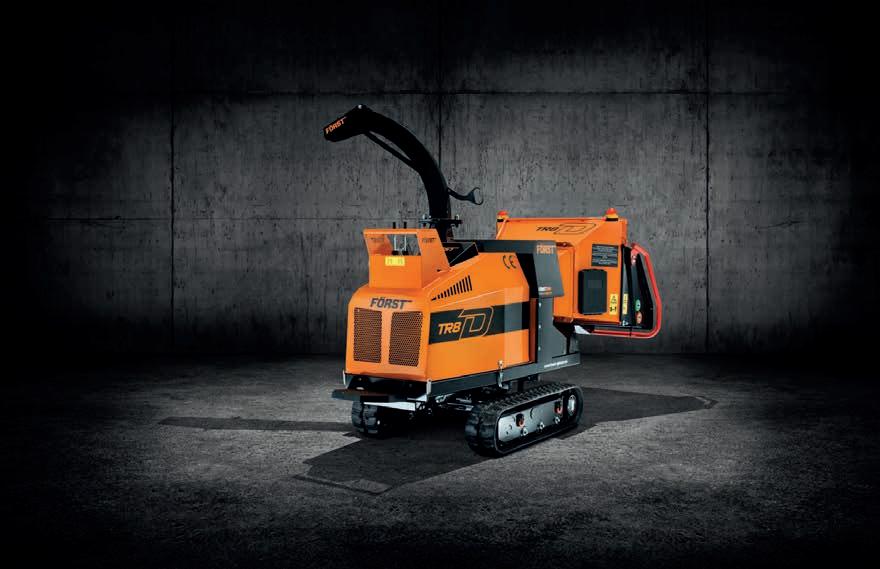

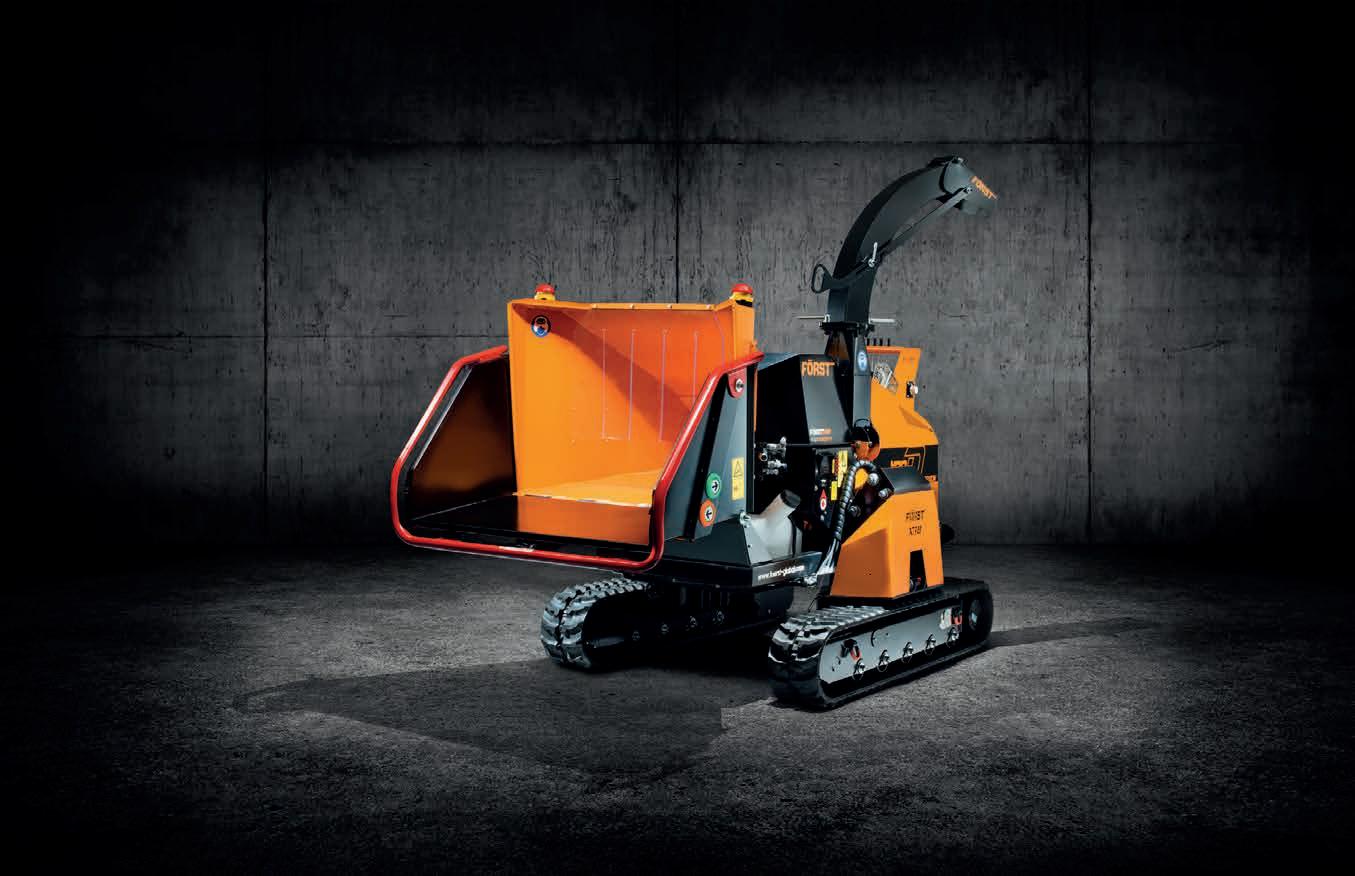
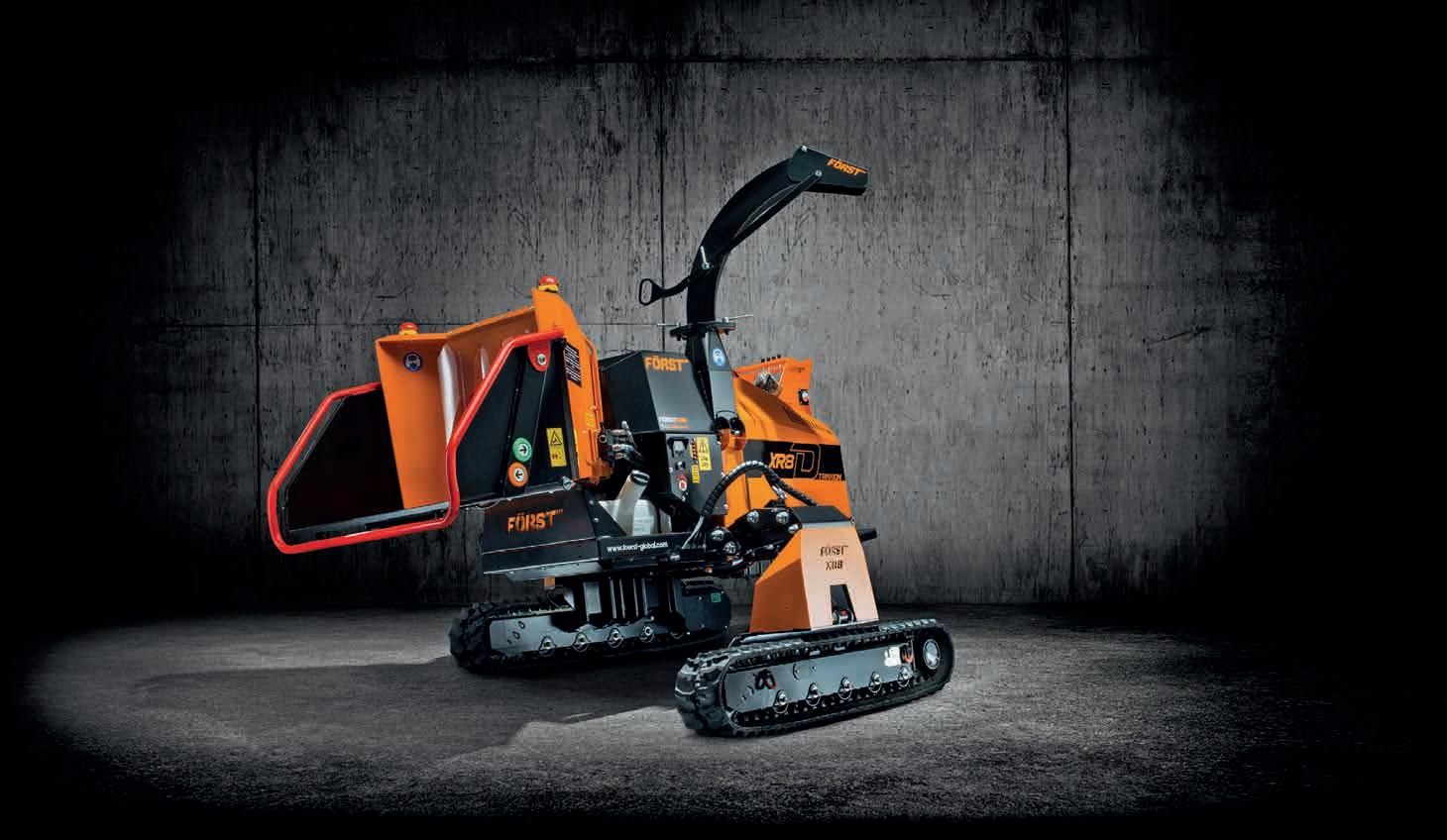

Equipped with standard Först benefits
such as ‘FörstGrip’ feed rollers for optimal crushing power, the ‘Open Flywheel’ system, and ‘AutoIntelligence’ stress control, this wood chipper delivers exceptional performance.
Built to withstand the rigours of daily arborist use, the 8D series showcases a robust construction with strengthening supports, gussets in key areas, all-steel panels, large ‘C’ sections, and oversized
bearings throughout. Arborists can choose between wheeled and tracked models, with the ST8D weighing in at 1450kg, the TR8D at 1600kg, and the XR8D at 2250kg.

For those requiring a road-ready version, Först offers an easily towable model complete with heavy-duty running gear, a fully braked chassis, and a handbrake, ensuring safe and effortless
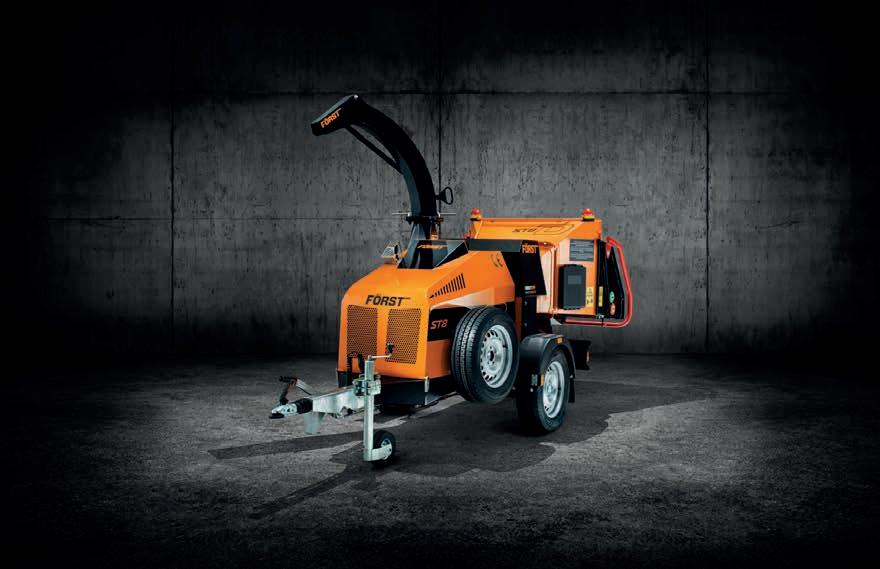

transportation to and from job sites. Since its launch in 2013, the UK-based Först brand has quickly become a market leader for commercial wood chippers across Europe. Now, Australian arborists, rail contractors, local authorities, powerline contractors, and rental/hire companies are embracing the brand, thanks to its unwavering commitment to performance and reliability. Först further

demonstrates its confidence in its products by being the first company in the industry to offer a comprehensive three-year, noquibble warranty on all machines.
See what the fuss is all about and look into Global Machinery Sales all-new long-term rental solution where you can pull out at any point. For more information, please call Global Machinery Sales on 1300 072 926 or visit globalmachinerysales.com.au.
Bluey’s Tree Removals couldn’t be happier with its new Vosch rotating grapple saw and Westtech Woodcracker splitting grapple from Forest Centre.
Based in Bayswater, Victoria, Bluey’s Tree Removals services Melbourne’s eastern suburbs, the city itself, and the Dandenong region. These days Bluey’s Tree Removals does most of its work for commercial clients and runs the equipment it needs for commercial operations. As the company grows, the focus on larger and heavier machinery is increasing. The company’s equipment includes trucks, chippers, excavators, stump grinders, and a skid-steer loader. Owner Paul Robinson has recently
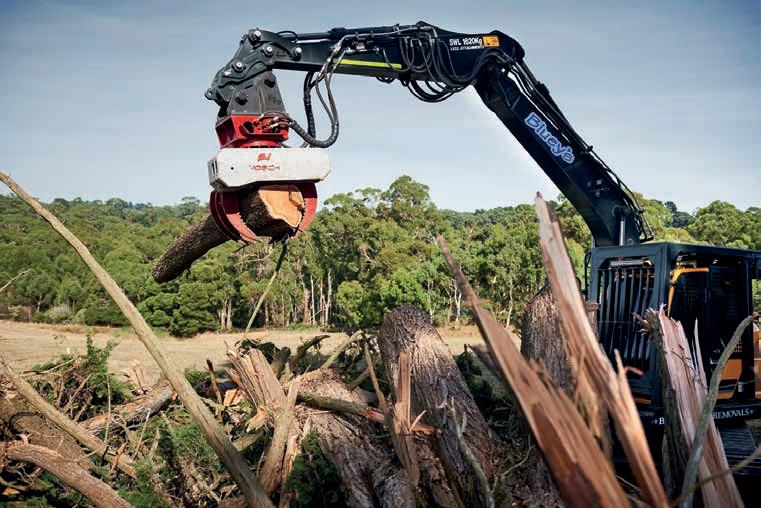
added a couple of attachments from Forest Centre: a Vosch grapple saw and a Westtech Woodcracker splitting grapple. Although the new attachments are recent additions, Paul is clearly very happy with both.
The Westtech is especially interesting. It’s a new name in the Forest Centre catalogue, and if Paul’s reaction is anything to go by, Westtech will be
around for a long time to come.
“It performs great!” said Paul, referring to his W1350 with 360-degree rotation, which is designed specifically for breaking down large-diameter tree sections for ease of further processing.
“We get logs back from the job and they’re no good for the sawmill and we don’t deal with firewood. They used to be a bit of a pest. Now we just get out the Westtech, split ’em all up and run ’em through the chipper. That’s it. Job’s done. We don’t have to worry about anything.
“We’ve had the Woodcracker for at least six months, or maybe a bit longer. It goes on the 10-ton excavator, and we’re getting an adaptor made to put it on the 15-tonner.”
When tackling serious clearing works, Paul has found his new Vosch rotating grapple saw to be an asset in every way.
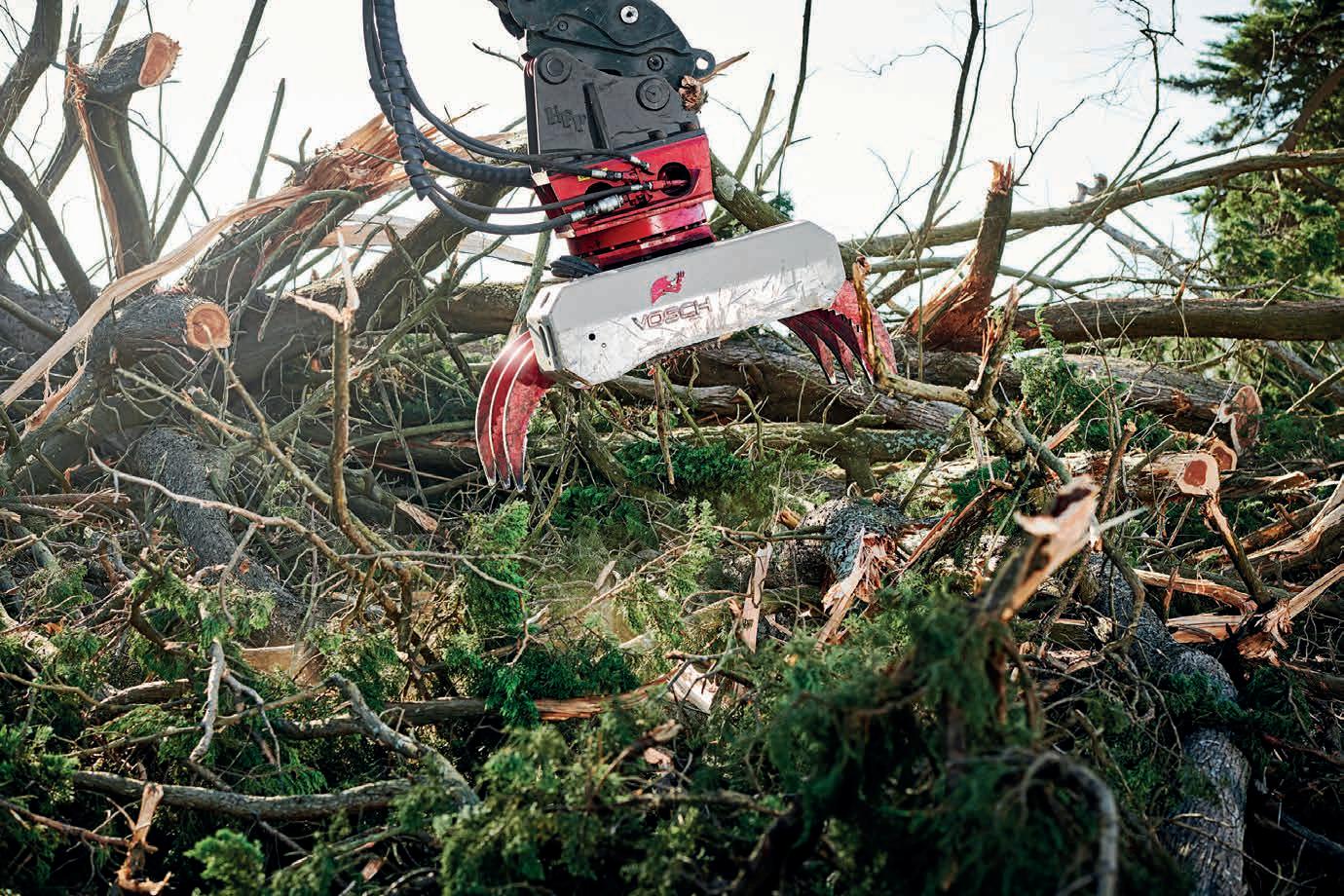

“I’ve had to get my head around how to utilise the Vosch best. Once you do that, you suddenly realise just how much it can do,” Paul explained.
“I’m doing undercuts and top cuts on sections of big cypress trees that are way too big to hang on to. But with the Vosch I
can just cut ’em up high and let ’em come off the tree. I never would’ve thought I could do all the things I can with it.
“Now it just comes down to the operator being good enough to do what the saw can do and understand the capabilities.”
It’s the versatility of the Vosch grapple which has caught Paul’s attention. That and the safety aspects of its use.
“It’s very, very handy,’ he said.
“It’s especially good for trees on the ground. We’re dropping cypress trees that are 100-foot high and four- or fivefoot diameter at the base, and you’ve got multiple leaders. With the Vosch I don’t need to put anyone in there with a chainsaw. I just pick the whole tree apart, basically back to a trunk, and I do the whole thing from sitting in the cabin. No one’s trying to climb over branches, no one’s worried about it rolling over, no one’s getting in pinch points or crush zones or anything like that. It gets the whole OH&S side of it under control…I don’t have to worry about anyone being in there. That’s a huge advantage. Not just when trees are in the air, but when they’re on the ground. No one’s in harm’s way, and it’s just so much more efficient.”


Forest Centre has played a big part in Paul’s satisfaction in his purchasing decision, and Forest Centre Sales Manager Rey Kell is clearly focussed on customer service.
“Rey’s been great!” grinned Paul.
“I can ring him pretty much any time within reason, and he just makes himself available. And he knows the products, which is really helpful. There’s nothing worse than ringing
people who’ve got no idea.
“We’ve run a few ideas past him with a few different options we’ve been looking at for the company, and he’s been really good – really helpful with everything.
“I certainly can’t complain about anything with Forest Centre.”
It looks as though Bluey’s Tree Removals and Forest Centre are a firm alliance, and will be for the foreseeable future.

Impressed with the performance of its first Hansa chipper purchased six years ago, this New South Wales-based business has since bought two more.

Addicted to Gardens is an arbor business which focuses on the form, structure, and overall health of trees. Owner Matthew Pittard has found the versatility and efficiency of Hansa chippers ideally suited to the company’s aims.
“Since the company started, we always used Hansa,” he reflected. “I originally bought the five-inch C21 and quickly upgraded to the seveninch C40 diesel chipper. It was a gamechanger for me.
“Then we moved to the 10-inch C65 Hansa in 2021.”
Through clever design, Hansa’s C65 boasts extraordinary capacity-toweight ratio, tipping the scales at under
1950kg and offering uncompromised performance. The 10" capacity is accentuated by a wide feed opening, and it’s often described as a ‘small in size but big in capacity’ chipper.
“The Hansas are so easy to tow around,” said Matthew. “I can even push it by myself to where I want it if we’re on a flat, and when we have jobs we can’t get into with the truck, like boggy ground or limited height, I’ve also got a 4WD and I can just hook the chipper on. That’s been really handy.”
With a variety of optional extras available for the C65, Matthew is grateful he opted for both the lift-andcrush and hydraulic-winch features.
“When you’re putting in bigger logs,
being able to lift the roller so you can get in underneath and drive it in – as opposed to hoping the rollers are going be able to drive it up and over –effectively triples the bite force and can be controlled from either side of the chipper.”
Matthew adds, “Most (arborists) think there’s no alternative to the big, massive machines made in America, but why? There’s a really good product coming right from our doorstep in New Zealand.”
As a final thought Matthew offered, “I like the fact I can customise the colour. Everything matches. I keep my business well-presented and I believe it makes a difference. Customers have even told me that’s why they called me.”
Hansa’s
boasts extraordinary capacity-to-weight ratio, tipping the scales at under 1950kg and offering uncompromised performance.



Researchers from UNSW Sydney and the Australian Institute of Botanical Science, part of the Royal Botanic Gardens and Domain Trust, surveyed 33 major online databases of plant photographs to examine the photographic record of Australian plant species. The findings, published in New Phytologist, reveal out of 21,077 native Australian vascular plant species, almost 20 per cent lack a verifiable photograph.
Lead author of the study and UNSW Science PhD student Thomas Mesaglio pointed out Australia is one of the richest areas in the world for native species.
“It was surprising to see how many plant species had just line drawings, illustrations, paintings, or even no media at all,” Mr Mesaglio said.
Dr Hervé Sauquet, co-author of the study and Senior Research Scientist at the Australian Institute of Botanical Science, is based at the National Herbarium of New South Wales.
“All species of plants ultimately rely on specimens in herbarium collections for their identification,” Dr Sauquet said. “Yet, even in this digital age where most herbarium specimens have been scanned and are accessible on the web, photos of live plants in the wild remain
in critical need.”
Senior author of the study from UNSW Science, Associate Professor Will Cornwell, said a lack of detailed photos can have real consequences. Many plant species that are difficult to identify in the wild may face extinction if scientists cannot properly identify them with the help of photos.

“We had assumed every plant species would have simply been photographed by someone, somewhere, throughout history. But it turns out this isn’t the case,” said A/Prof. Cornwell.
“This is where citizen scientists can come in and help us fill this gap with their photos.”

taxonomists who work with plant specimens by preserving characteristics like flower colour that get lost over time in their samples. They can also show additional features, such as the orientation of leaves or bark appearance, and add ecological context.
“Having a comprehensive photographic set helps us to be confident in our identifications,” said Mr Mesaglio. “Particularly when it is practically challenging to collect
and preserve the entire plant. Photos complement the physical voucher by showing the soil type, the habitat it’s growing in, and other species growing alongside it.”
But it turns out not all plant groups are photographed equally.
The study found the most photographed plant groups were shrubs or trees with more noticeable or spectacular features, such as colourful flowers. Banksia, for example, is one of only two Australian plant genera with more than 40 species to have a complete photographic record.
“We noticed a charisma deficit, so the species that tend to be harder to see are the ones missing out,” said Mr Mesaglio. “They may have innocuous or pale-looking flowers or might be smaller and harder-to-spot grasses, sedges and herbs.”
“The primary ‘hotspots’ for unphotographed Australian plants are areas with high plant diversity, but the environments are rugged and often difficult to access, particularly by road,” said Mr Mesaglio. “But it means there’s an exciting opportunity to visit these locations because we might capture something that has never before been photographed.”
New research has found almost 4000 Australian plant species have not been photographed in the wild.Snap a phone pic of any interesting plants and trees and post your pics on inaturalist.ala.org.au.
Log your pics

It’s one thing to have comprehensive photographic records for professional scientists to use in identification guides. But when the plant world is under threat from multiple fronts, including habitat clearing and climate change, photos can help engage the public in plant science.
“Because digital photography is so accessible now, anyone can also help make a meaningful contribution to science using the camera in their pocket,” said Mesaglio.
Using a platform like iNaturalist, keen citizen scientists can have their snaps identified by experts and share the data with aggregators like the Atlas of Living Australia and the Global Biodiversity Information Facility to be used in

research and conservation.
“Since April last year, we’ve identified nearly 10 per cent of those previously unphotographed species thanks to members of the public uploading their photographs and experts who’ve kindly identified them,” Mr Mesaglio said. “There could be many more in personal collections or behind paywalls just waiting to be shared.”
The researchers recommend a standardised system for scientific plant photography be developed, starting with a requirement in the International Code of Nomenclature for Plants to include at least one field photograph where possible in new species’ descriptions. They also suggest all new species’ descriptions be published as
Open Access in searchable databases with Creative Commons licensing to maximise their usage.
So what about it? Arborists are better equipped to recognise plant types than most, and they’re often in less-accessible locations. Surely the arboriculture industry can contribute?

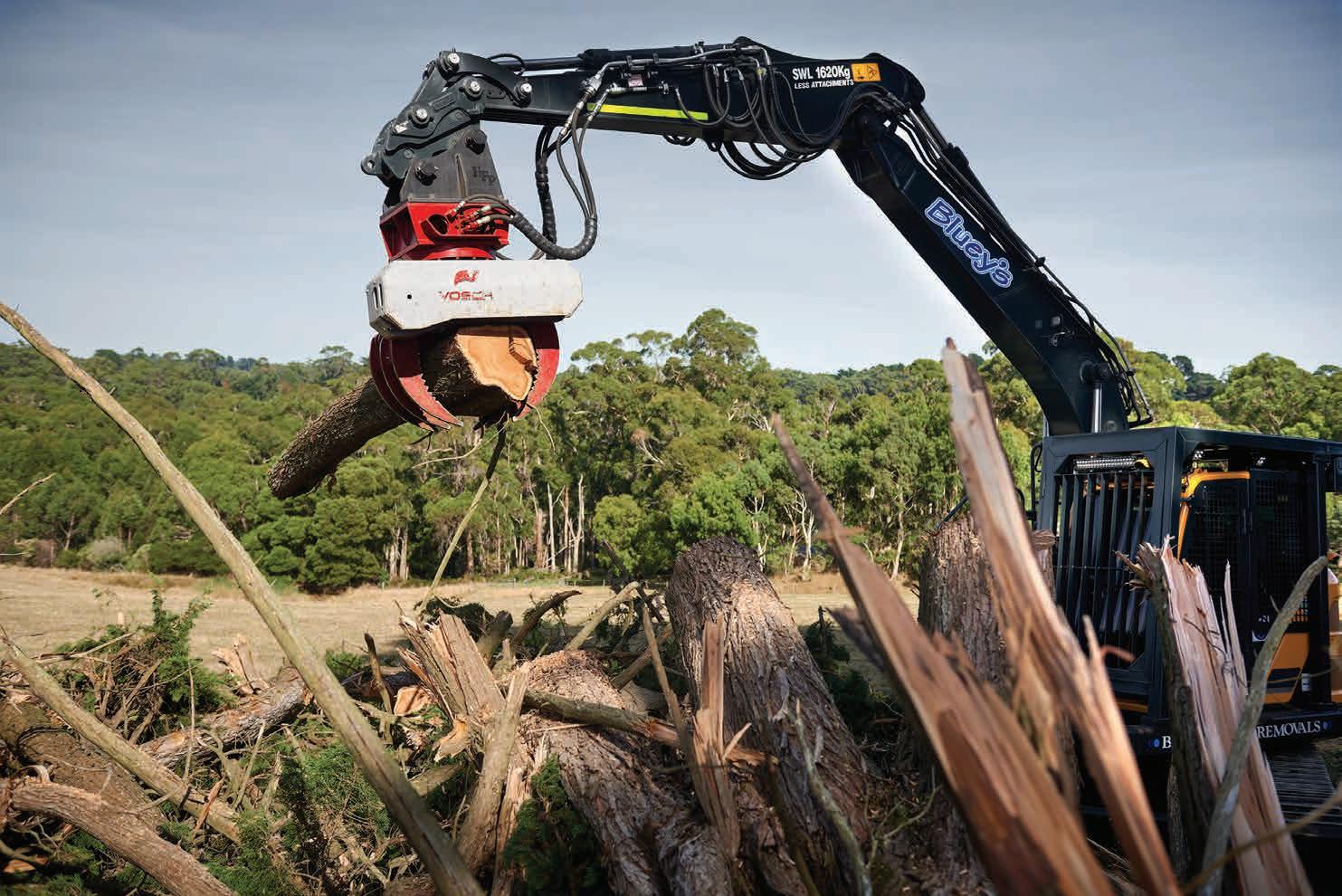
Keep your eyes open for less-common plant types and snap a phone pic of anything interesting. Log your pics on inaturalist.ala.org.au, and make sure you send us a copy here at Arbor Age. Tell us what you found and where.
In fact, we’re keen to see any pics you’d like to share of trees. Send them to tom.foster@primecreative.com.au with some info about why you think the tree’s special and we’ll share them.
 Arborists are better equipped to recognise plant types than most.
Arborists are better equipped to recognise plant types than most.
A world-leading program to report on the health of NSW national parks is underway with more than 600 surveillance sites across eight nationalparks’ areas to track long-term trends in biodiversity.
Minister for Environment, James Griffin, said the program is the largestever systematic survey for the NSW national-park estate, and one of the biggest in the world.
“What we don’t know, we can’t protect, and by monitoring the health of our national parks through new animalcamera traps, acoustic monitoring and vegetation surveys, we’ll be able to
paint an even clearer picture to better protect these critical habitats,” said Mr Griffin.
“Targeted surveys will be carried out at each of the national-park areas to monitor threatened species, such as koalas, powerful owls and Wollemi pines. A different set of surveys will track populations of feral animals and weeds and generate fire-management metrics.
“The NSW Government is delivering the largest investment in our park estate – more than doubling feralanimal control, increasing the number of firefighters and committed to zero extinctions within parks.”
Surveys are already underway in Kosciuszko and Royal National Parks, with camera traps already generating a wealth of data and showcasing the diversity of wildlife.
Initially, 30% of the national-park estate will be monitored, including the Blue Mountains World Heritage Area, Macquarie Marshes, Myall Lakes, the Pilliga, part of the Gondwana Rainforests World Heritage Area, Kosciuszko and Royal National Park.

The surveillance network alone will involve more than 2400 camera traps, 1200 acoustic devices and 1200 bird surveys. Vegetation surveys and soil samples will provide additional data on the health of park habitats.
The monitoring has four components, including:
• Park-wide surveillance monitoring for trends in mammal, bird, frog and reptile populations, and vegetation surveys and soil samples to provide additional data on the health of park habitats
• Regular, targeted surveys to monitor threatened species such as koalas, powerful owls and Wollemi pines
• Measurement and reporting of fire metrics
• Monitoring of threats, including feral animals and weeds.
The results will be published in publicly available National Park Scorecards, providing a rich, data-based picture of the

Initially, 30% of the national-park estate will be monitored, including the Kosciuszko and Royal National Parks.

health of our national parks.
Over time, the scorecards will mean everyone can track the health of their favourite national park, with annual updates on whether biodiversity is improving and whether feral animals and weeds are decreasing.

The initiative is supported by a $7 million grant from the NSW Environmental Trust and philanthropic investment of $1 million.
For more information on the programs, visit National Park Performance Scorecards pagelaunch on the Environment NSW website.
The National Park Performance Scorecards page on the Environment NSW website will allow the public to track results.

Targeted surveys will be carried out to monitor threatened species such as koalas, powerful owls and Wollemi pines.
are underway and generating a wealth of data and showcasing the diversity of wildlife.
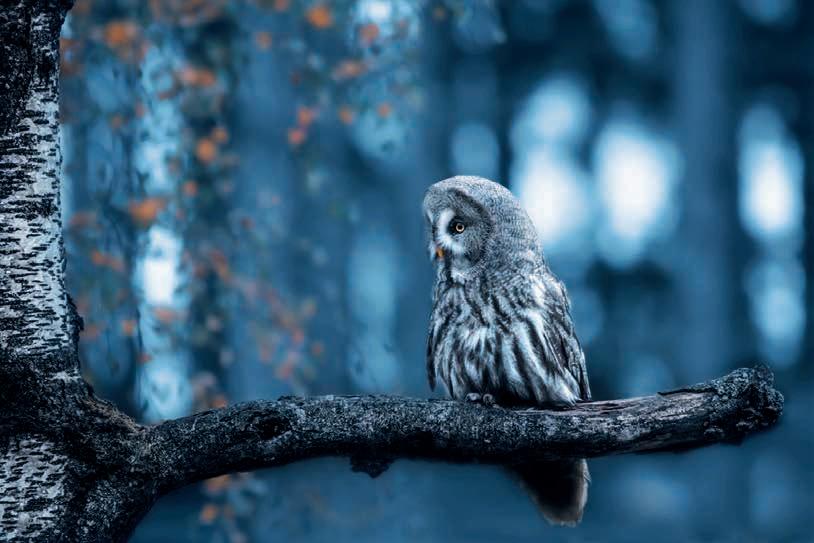
While it may be easier to go direct, especially with the growing availability of online products, a broker can provide you with added value and assistance when you most need it.
Small businesses on tight margins are very aware of costs, so it’s easy to always opt for the cheapest product. But when it comes to insurance, choosing the cheapest option can have expensive consequences.
If a policy appears too good to be true, it’s likely to be just that. You may find that when it comes time to make a claim, you aren’t covered for what you need. Insurance brokers are able to compare policy prices and features to ensure you not only get value for money, but you are also fully covered for your requirements.
While there are a number of online sites that can do an instant comparison of insurance companies and policies,
these offerings don’t take your specific situation into consideration.
A broker can provide a thorough assessment of your insurance needs and find a policy that better suits your specific needs. It may take a little longer than getting an online recommendation, but you can rest assured that you’ll get the coverage you need.
‘If a policy appears too good to be true, it’s likely to be just that’.
Know who you’re dealing with Buying insurance direct may be easy and straightforward, but what about when you need to make a claim?
We’re all familiar with the frustration of waiting on hold for a customer representative to get to us, only to be transferred to another department to deal with your particular request.
When you work with a broker, not only do you have an established relationship with the person who advised you on your policy, if you need to make a claim, you can hand the process over to them, leaving you free to run your business.
Daniel Holmes, Fitzpatrick General Manager, said the greatest risk of dealing with your insurance needs yourself is not understanding the product you’re buying.
“Liability policies can also be confusing. If you don’t fully understand what you’re buying, then what you end up with may not be the most appropriate product for you. But you won’t know that until it comes time to make a claim.”
He adds the advantages of using a broker come into their own when there is a high-value claim.
“If someone’s business premises has been destroyed and they have a $300,000 claim, then it can be very timeconsuming compiling all the information needed to complete the claim,” he said. “This is when you’re going to want someone who knows about insurance to be managing that process for you.”
Never used an insurance broker before? Talk to a broker today about the benefits they can bring to your business.
This article provides information rather than financial product or other advice. The content of this article, including any information contained in it, has been prepared without taking into account your objectives, financial situation or needs.
For more information or questions on your own policy, please contact Fitzpatrick & Co. Insurance Brokers on 03 8544 1600 or email: insure@ fitzpatrick.com.au OR visit the website at fitzpatrick.com.au.
Fitzpatrick & Co has specialised in the horticulture and arboriculture industry for over 30 years, providing assistance and financial support to companies, associations and events. Fitzpatrick is there when your industry needs you.

When it comes to buying insurance, the choices are simple: do it yourself or use an insurance broker.


Customer satisfaction is our #1 goal. Oliver from O.S. Trees in Bathurst is a testament to that. Oliver has been a proud Bandit customer for over 10 years, with a range of chippers starting from a 6-inch right through to a 21-inch. Oliver needed an even larger chipper in his fleet, and the new Bandit 20XP HD was the perfect fit.“These bigger machines are more cost-effective for the client,” says Oliver. “They’re getting through more work. Production-wise, and with the remote eliminating that extra man on the ground.” Having a service team backing him up is an important part in keeping Oliver’s business on track. “The support from Terry for parts and service is all good and positive. And I think Bandit will do well with the new EEA Group branch in Orange” says Oliver. Customers like Oliver are the reason why we love what we do at Bandit. Our goal is simple. To ensure you have an outstanding experience with your Bandit machine every day. Welcome to the Bandit Family.


